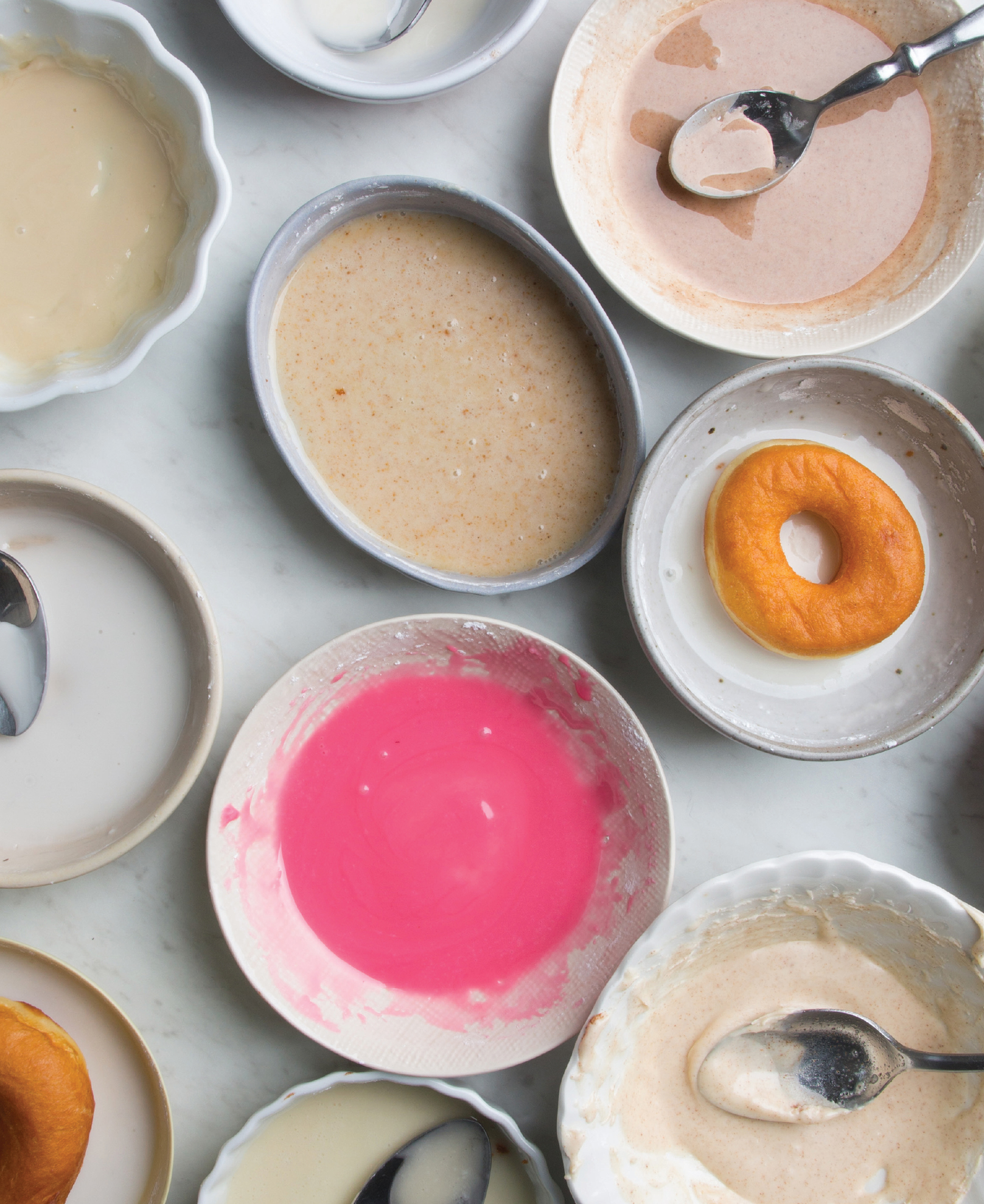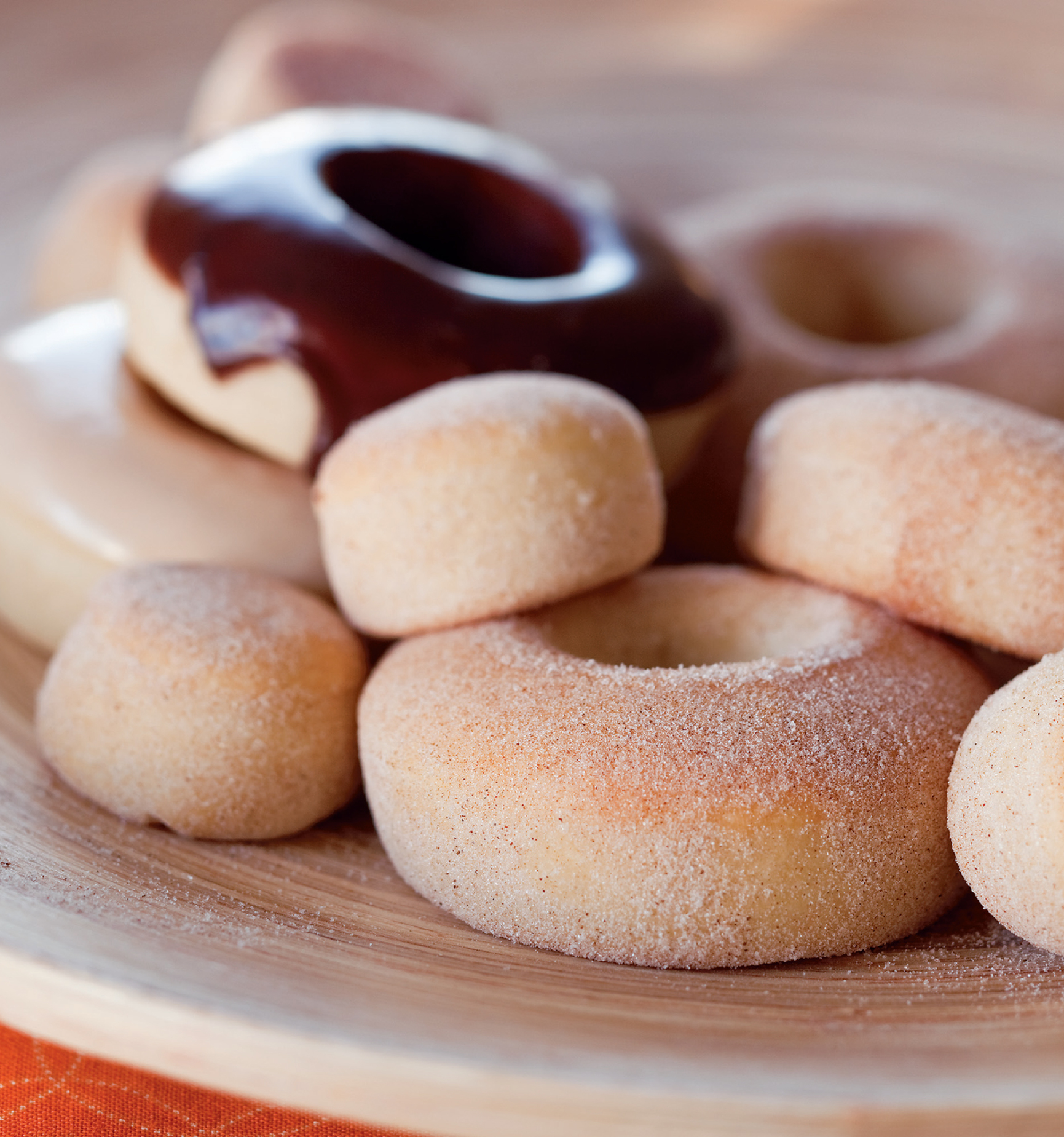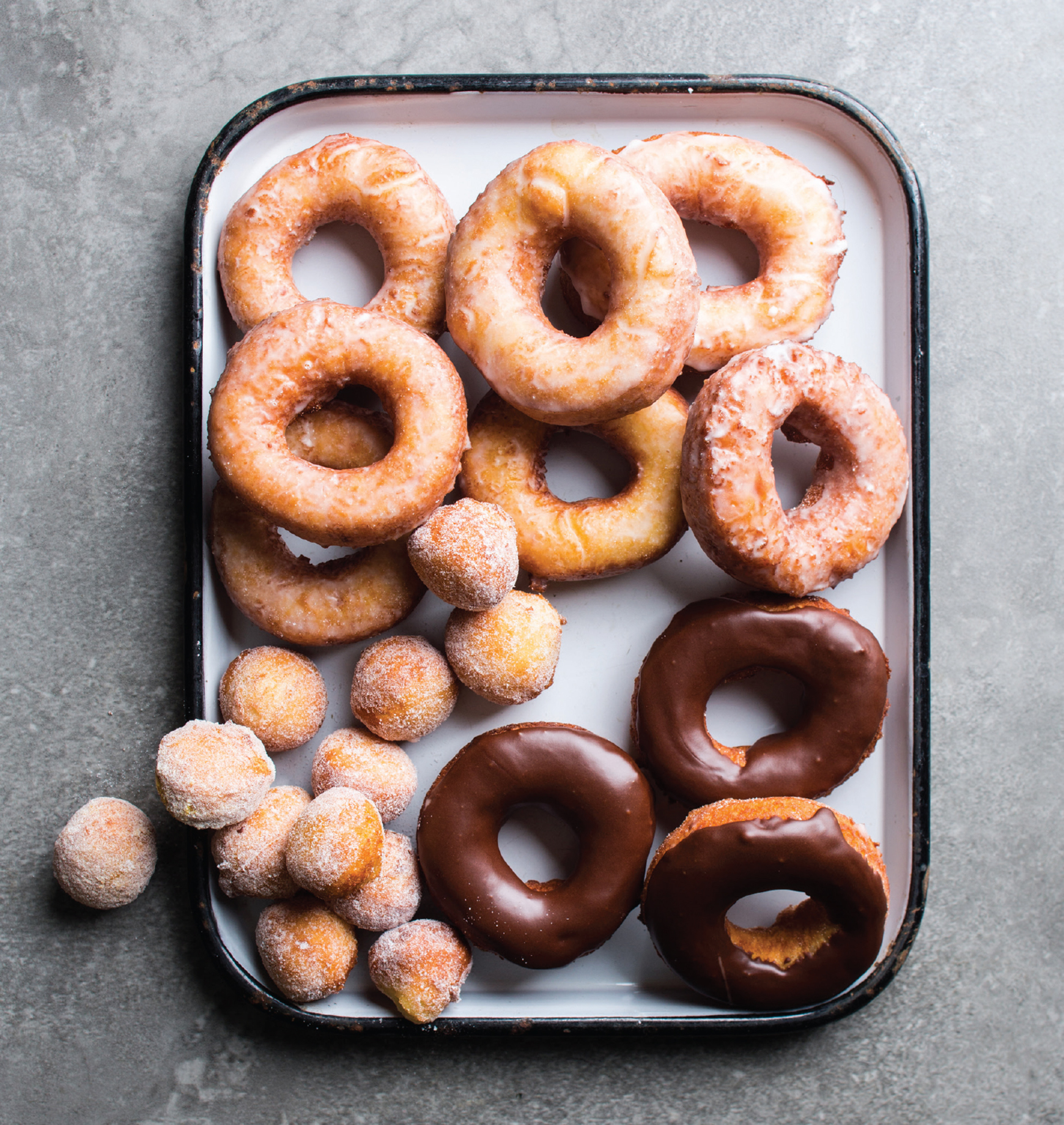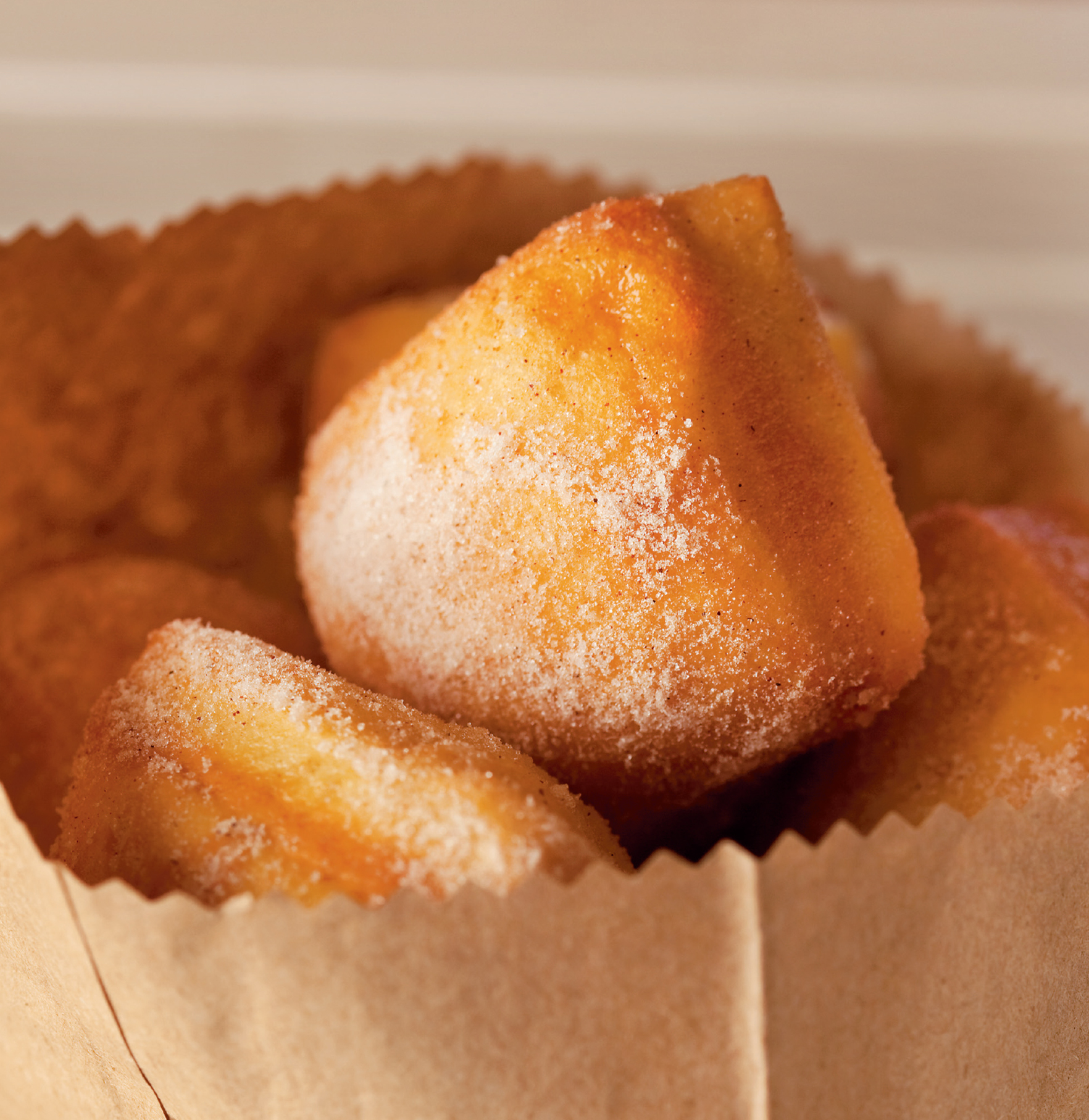
DOUGHS
BASIC RAISED
The quintessential doughnut: fluffy, sweet, heavenly. There’s nothing like a still-warm raised doughnut to bring a smile to your face. This basic dough recipe is very subtly sweet, so you can glaze away with your favorite flavors and not worry about the doughnuts getting cloying. This updated version is less yeasty than my original recipe but just as fluffy.
MAKES 8 TO 12 DOUGHNUTS | ACTIVE TIME: 25 MINUTES | READY IN: 3 HOURS
1 tablespoon plus 1 teaspoon active dry yeast, divided
1 cup whole milk, heated to 110 degrees F, divided
2 to 3 cups (240 to 360 grams) bread flour, divided, plus more for dusting
3 egg yolks, at room temperature
1 teaspoon vanilla extract
2 tablespoons superfine sugar
½ teaspoon kosher salt
¼ cup (½ stick) unsalted butter or vegetable shortening, at room temperature
Vegetable oil for frying
• In a medium bowl, dissolve 1 tablespoon of the yeast in ¾ cup of the milk. Add ¾ cup of the flour and stir to create a smooth paste. Cover the bowl with plastic wrap and let it rest in a warm spot for 30 minutes.
• In the bowl of a stand mixer fitted with the paddle attachment, combine the remaining ¼ cup milk and 1 teaspoon yeast with a spoon. Add the rested flour mixture, egg yolks, and vanilla. Mix on medium speed until smooth. Turn off the mixer and add 1 cup of the flour, the sugar, and salt. Mix on low speed for about 30 seconds or until the dough starts to come together. Add the butter and mix on medium speed until incorporated, about 30 seconds.
• Switch to the dough hook attachment. With the mixer turned off, add more flour, about ¼ cup at a time, and knead the dough on medium speed between additions, until the dough pulls completely away from the sides of the bowl and is smooth. It will be very soft and moist, but not so sticky that you can’t roll it out. You may have flour left over. Cover the bowl with plastic wrap and let it sit in a warm spot for 30 minutes. Gently degas the dough and refrigerate for at least 1 hour (and up to 12 hours).
• Line a baking sheet with a lightly floured non–terry cloth dish towel. Roll out the dough on a lightly floured surface to ½ inch thick. With a doughnut or cookie cutter, cut out 3-inch rounds with 1-inch holes (for filled doughnuts, don’t cut out the holes).
• Place the doughnuts on the prepared baking sheet at least 1 inch apart and cover with plastic wrap. Let them sit in a warm spot to proof until almost doubled in size, 30 to 40 minutes, testing at 5-minute intervals. To test whether the dough is ready, touch it lightly with a fingertip. If it springs back immediately, it needs more time. If it springs back slowly, it is ready. If it doesn’t spring back at all, it has overproofed; you can punch it down and reroll and reproof it for another 30 minutes once.
• While the doughnuts are proofing, in a heavy-bottomed pot, heat at least 2 inches of oil until a deep-fat thermometer registers 360 degrees F. With a metal spatula, carefully put the doughnuts in the oil. Fry for 1 to 2 minutes on each side, or until light golden brown. Remove with a slotted spoon, drain on a wire rack set over a paper towel, and let cool slightly before glazing or filling.
NOTE: Have leftover dough scraps? Make doughnut bread! Just knead the scraps together and put in a greased brioche pan, or form into rolls and put in a muffin tin. Brush the tops of the dough with milk or melted butter, cover with plastic wrap, and let sit in a warm spot for 15 minutes. Preheat the oven to 425 degrees F, and bake for about 12 minutes, or until deep brown on top. Let the bread cool on a wire rack for at least 10 minutes.
BAKED RAISED
Most baked sweet doughs end up more like bagels than doughnuts, but these, based on a Finnish sweet dough recipe, are so soft and light you may not realize they were baked. A quick dip in glaze will keep the crust from becoming too chewy, but they are still best eaten straight away.
MAKES 10 TO 14 DOUGHNUTS | ACTIVE TIME: 20 MINUTES | READY IN: 2 HOURS
1 egg, at room temperature
¼ cup (60 grams) superfine sugar
1 cup whole milk, heated to 110 degrees F
1 tablespoon active dry yeast
2 teaspoons vanilla extract
1 teaspoon kosher salt
2½ to 3½ cups (300 to 420 grams) all-purpose flour, divided, plus more for dusting
½ cup (1 stick) unsalted butter, cut into 1-inch cubes, at room temperature
Vegetable oil for greasing
• In the bowl of a stand mixer fitted with the paddle attachment, beat the egg and sugar on medium speed until blended, about 1 minute. Add the milk, yeast, vanilla, and salt and mix on medium speed to blend. With the mixer on low speed, add 2 cups of the flour about ½ cup at a time, and beat until the dough is thick and pulls away from the sides of the bowl, about 2 minutes.
• Switch to the dough hook attachment. With the mixer on medium speed, add the butter one piece at a time, and beat until no large chunks are left in the bottom of the bowl, 3 to 5 minutes. Reduce the speed to low and add additional flour until the dough gathers around the hook and pulls completely away from the sides of the bowl. It will be soft and moist, but not overly sticky. You may have flour left over.
• Turn the dough out onto a floured surface and knead gently until the dough no longer sticks to your hands. Lightly grease a large mixing bowl. Transfer the dough to the bowl and turn to coat. Cover with a damp tea towel or plastic wrap and let rise in a warm spot until doubled in size, about 1 hour.
• Punch down the dough and roll out to ½ inch thick, lightly flouring the surface if the dough sticks. With a doughnut or cookie cutter, cut out 3-inch rounds with 1-inch holes (for filled doughnuts, don’t cut out the holes).
• Preheat the oven to 400 degrees F and line a baking sheet with parchment paper. Place the doughnuts at least 1 inch apart on the baking sheet. Cover with plastic wrap and let them sit in a warm spot until nearly doubled in size, about 20 minutes.
• Bake until the doughnuts are a light golden brown, 5 to 8 minutes, being very careful not to overbake them. Immediately glaze them, or brush with butter and dust with superfine sugar, and eat while still warm.
GLUTEN-FREE BASIC RAISED
Didn’t think you could have raised doughnuts anymore because you can’t tolerate gluten? Think again. These gluten-free raised doughnuts may not be exactly like Krispy Kremes, but I think they’ll satisfy the craving.
MAKES 8 TO 12 DOUGHNUTS | ACTIVE TIME: 20 MINUTES | READY IN: 2 HOURS
2 to 3 cups Gluten-Free Baking Mix for Yeast Doughnuts
½ tablespoon baking powder
1½ tablespoons active dry yeast, divided
3 tablespoons superfine sugar
¾ cup whole milk, heated to 110 degrees F
2 eggs, at room temperature
1 egg white, at room temperature
2 tablespoons unsalted butter or vegetable shortening, at room temperature
1 teaspoon vanilla extract
1 teaspoon apple cider vinegar
½ teaspoon kosher salt
Tapioca starch for dusting
Vegetable oil for greasing and frying
• In a medium bowl, whisk the baking mix and baking powder.
• In the bowl of a stand mixer fitted with the paddle attachment, dissolve the yeast and sugar in the milk. Add 1 cup of the baking mix and mix on low speed to create a thick paste. Add the eggs, egg white, butter, vanilla, vinegar, and salt and mix on medium speed for 1 minute.
• Switch to the dough hook attachment. With the mixer turned off, add the remaining baking mix about ¼ cup at a time, and knead the dough on medium speed between additions, until the dough starts to pull away from the sides of the bowl and form a ball, 1 to 2 minutes. It will be very soft and moist, but not so sticky that you can’t roll it out. You may have baking mix left over.
• With lightly greased hands, form the dough into a ball and put it in a large ziplock bag. Let it rest in a warm spot for 30 minutes.
• Roll out the dough on a lightly floured surface to ½ inch thick. With a doughnut or cookie cutter, cut out 3-inch rounds with 1-inch holes (for filled doughnuts, don’t cut out the holes).
• Line a baking sheet with a lightly floured non–terry cloth dish towel. Place the doughnuts at least 1 inch apart on the baking sheet and cover with plastic wrap. Let them sit in a warm spot until they are nicely rounded on top, about 45 minutes.
• While the doughnuts are proofing, in a heavy-bottomed pot, heat at least 2 inches of oil until a deep-fat thermometer registers 340 degrees F. With a metal spatula, carefully put the doughnuts in the oil. Don’t overfill the pot. Fry for 1 to 2 minutes on each side, or until light golden brown. Remove with a slotted spoon, drain on a wire rack set over a paper towel, and let cool slightly before glazing or filling.
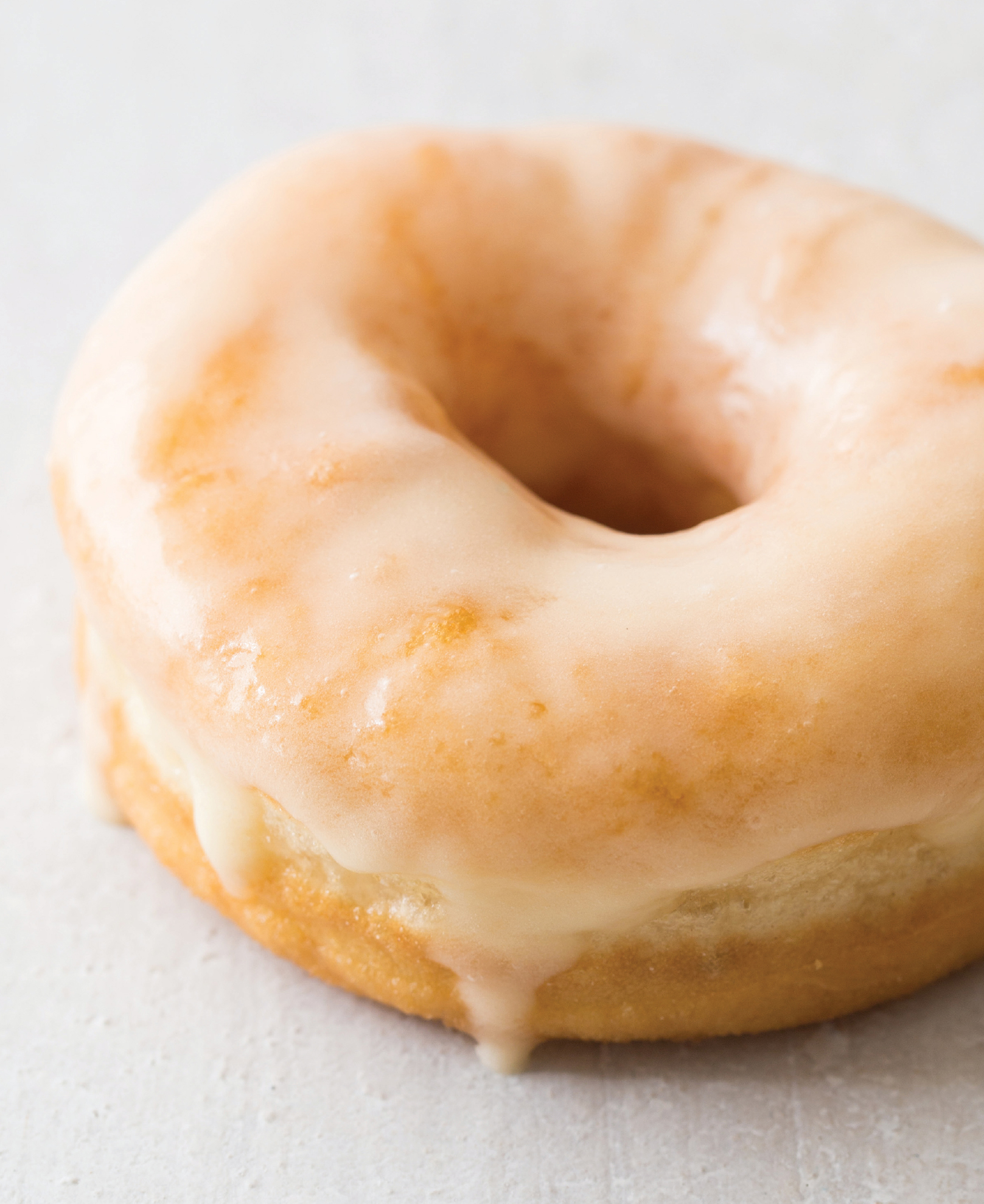
VEGAN RAISED
No animal products are required in this superlight and fluffy raised dough.
MAKES 8 TO 12 DOUGHNUTS | ACTIVE TIME: 25 MINUTES | READY IN: 3 HOURS
1 tablespoon plus 1 teaspoon active dry yeast, divided
1 cup almond milk (or milk of choice), heated to 110 degrees F, divided
2 to 3 cups (240 to 360 grams) bread flour, divided
2 tablespoons potato starch
1 teaspoon vanilla extract
2 tablespoons superfine sugar
½ teaspoon kosher salt
¼ cup coconut oil or vegetable shortening, melted
Vegetable oil for frying
• In a medium bowl, dissolve 1 tablespoon of the yeast in ¾ cup of the milk. Add ¾ cup of the flour and stir to create a smooth paste. Cover the bowl with plastic wrap and let it rest in a warm spot for 30 minutes.
• In the bowl of a stand mixer fitted with the paddle attachment, combine the remaining ¼ cup milk and 1 teaspoon yeast with a spoon. Add the rested flour mixture, potato starch, and vanilla. Mix on low speed until smooth. Turn off the mixer and add 1 cup of the flour, the sugar, and salt. Mix on low speed for about 30 seconds or until the dough starts to come together. Add the coconut oil and mix on medium speed until incorporated, about 30 seconds.
• Switch to the dough hook attachment. With the mixer turned off, add more flour, about ¼ cup at a time, and knead the dough on medium speed between additions, until the dough pulls completely away from the sides of the bowl and is smooth. It will be very soft and moist, but not so sticky that you can’t roll it out. You may have flour left over. Cover the bowl with plastic wrap and let it sit in a warm spot for 30 minutes. Gently degas the dough and refrigerate for at least 1 hour (and up to 12 hours).
• Roll out and cut the doughnuts, let rise, and fry as directed for Basic Raised doughnuts.
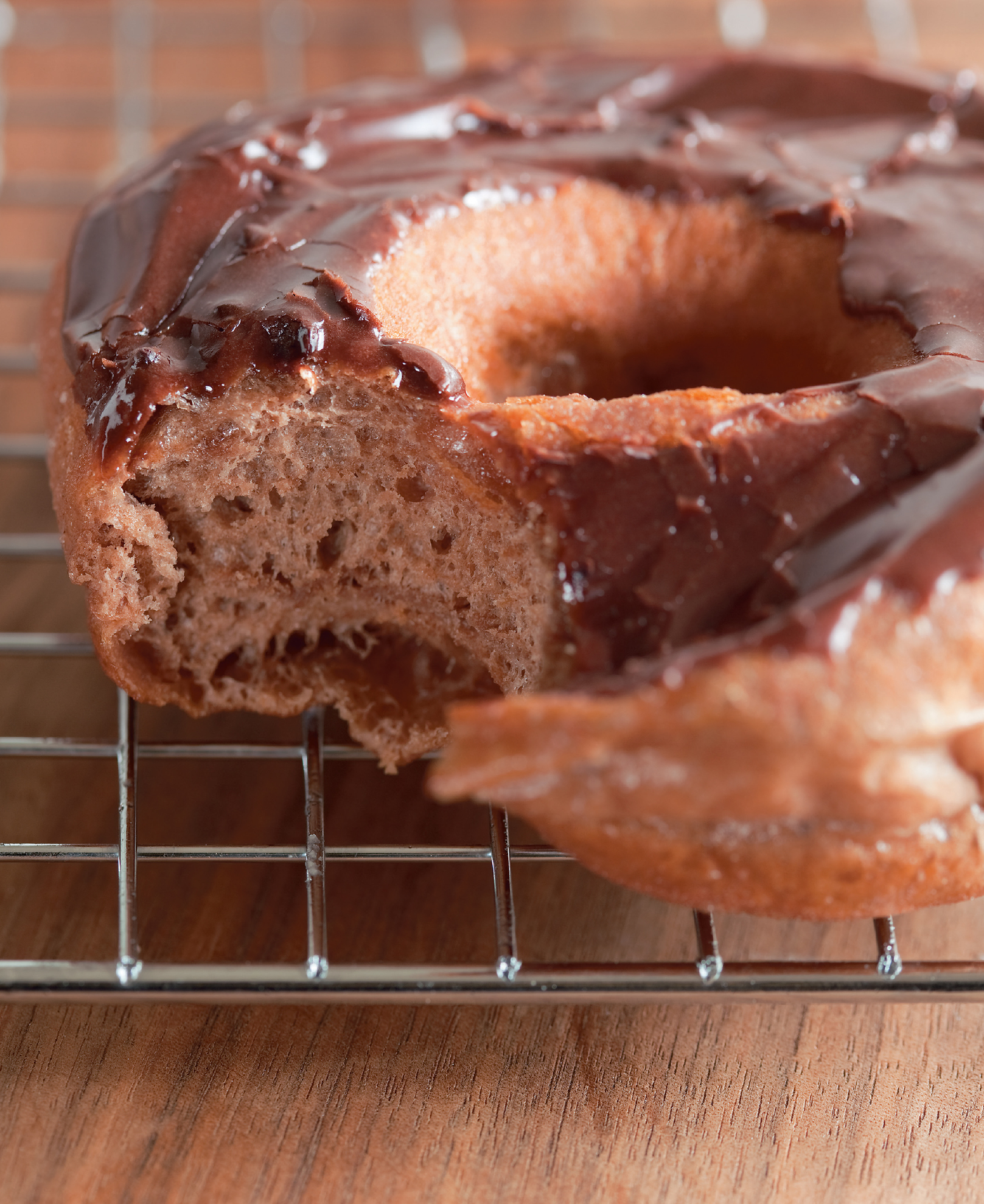
CHOCOLATE RAISED
Most chocolate doughnuts in bakeries are cake doughnuts. But for the true chocoholic, try this raised dough, which brings a fun chocolaty twist to basic raised doughnuts. Use Dutch processed cocoa powder for the most chocolaty flavor.
MAKES 8 TO 12 DOUGHNUTS | ACTIVE TIME: 25 MINUTES | READY IN: 3 HOURS
1 tablespoon plus 1 teaspoon active dry yeast, divided
1 cup whole milk, heated to 110 degrees F, divided
2 to 3 cups (240 to 360 grams) bread flour, divided
3 egg yolks, at room temperature
⅓ cup (28 grams) Dutch processed cocoa powder
1 teaspoon vanilla extract
¼ cup (60 grams) superfine sugar
½ teaspoon baking soda
½ teaspoon kosher salt
¼ cup (½ stick) unsalted butter or vegetable shortening, at room temperature
Vegetable oil for frying
• In a medium bowl, dissolve 1 tablespoon of the yeast in ¾ cup of the milk. Add ¾ cup of the flour and stir to create a smooth paste. Cover the bowl with plastic wrap and let it rest in a warm spot for 30 minutes.
• In the bowl of a stand mixer fitted with the paddle attachment, combine the remaining ¼ cup milk and 1 teaspoon yeast on low speed. Add the rested flour mixture, egg yolks, cocoa powder, and vanilla. Mix on medium speed until smooth. Turn off the mixer and add 1 cup of the flour, the sugar, baking soda, and salt. Mix on low speed for about 30 seconds or until the dough starts to come together. Add the butter and mix on low speed until incorporated, about 30 seconds.
• Switch to the dough hook attachment. With the mixer turned off, add more flour, about ¼ cup at a time, and knead the dough on medium speed between additions, until the dough pulls completely away from the sides of the bowl and is smooth. It will be very soft and moist, but not so sticky that you can’t roll it out. You may have flour left over. Cover the bowl with plastic wrap and let it sit in a warm spot for 30 minutes. Gently degas the dough and refrigerate for at least 1 hour (and up to 12 hours).
• Roll out and cut the doughnuts, let rise, and fry as directed for Basic Raised doughnuts.
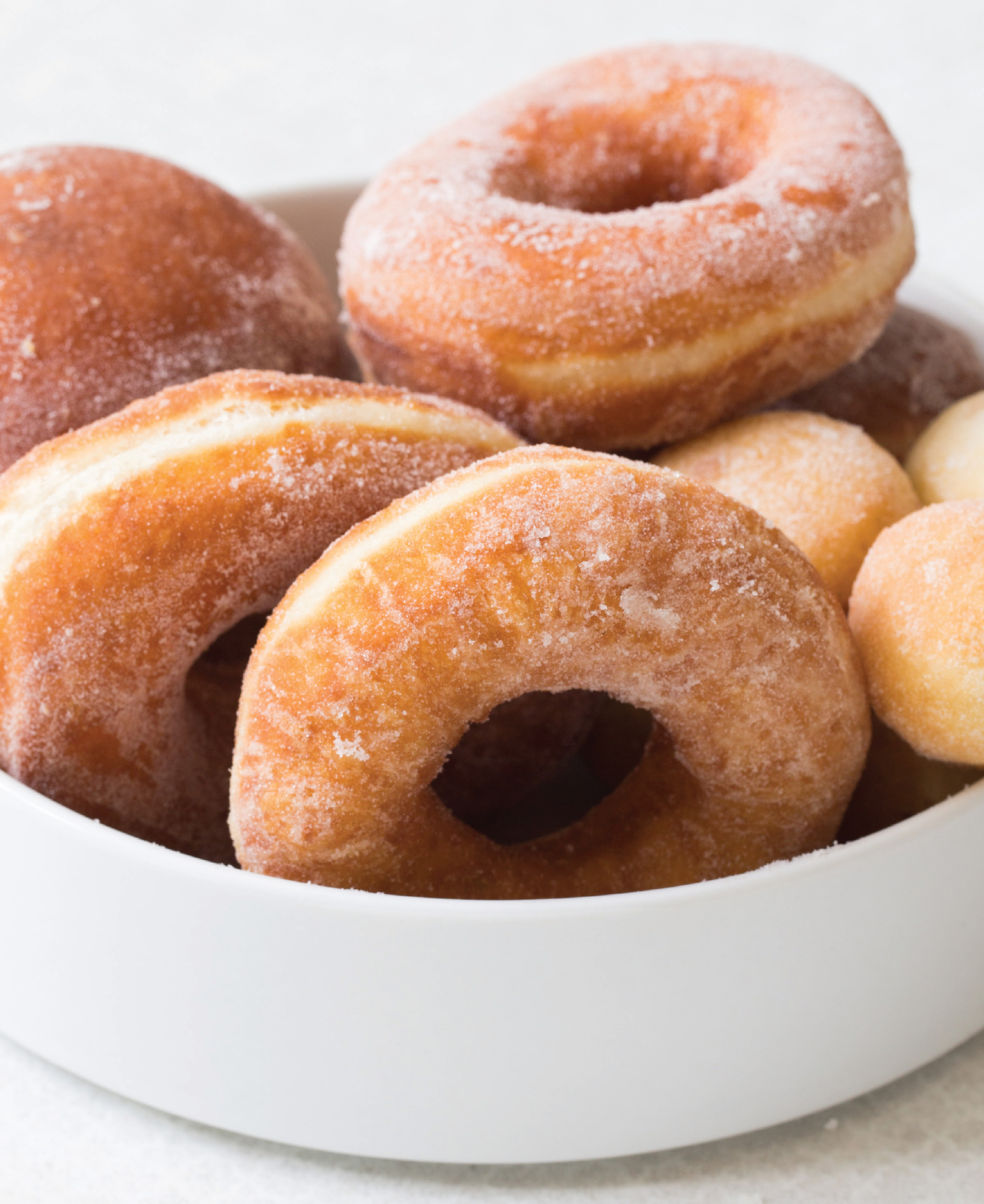
SOURDOUGH RAISED
Sourdough in raised doughnuts helps create an even more flavorful and fluffy dough with a little less yeast than traditional raised doughnuts. The sourdough starter does take some upkeep, but I think it’s well worth the babysitting for the extra boost to flavor it can provide for any of your baked goods, from breads to waffles to, of course, these doughnuts!
MAKES 8 TO 12 DOUGHNUTS | ACTIVE TIME: 25 MINUTES | READY IN: 4 HOURS
2 tablespoons Sourdough Starter (recipe follows)
2 to 3 cups (240 to 360 grams) bread flour, divided
¼ cup water
½ cup whole milk, heated to 110 degrees F
2 teaspoons active dry yeast
3 egg yolks, at room temperature
1 teaspoon vanilla extract
2 tablespoons superfine sugar
½ teaspoon kosher salt
¼ cup (½ stick) unsalted butter or vegetable shortening, at room temperature
Vegetable oil for frying
• In a medium bowl, combine the sourdough starter, ¼ cup of the flour, and the water. Stir to create a wet paste. Cover the bowl with plastic wrap and let it rest at room temperature for at least 1 hour (2 hours if the sourdough starter was cold to begin with), or up to 12 hours.
• After the sourdough has rested, in the bowl of a stand mixer fitted with the paddle attachment, combine the milk and yeast on low speed. Add the sourdough mixture, egg yolks, and vanilla. Mix on low speed until smooth. Turn off the mixer and add 1 cup of the flour, the sugar, and salt. Mix on low speed for about 30 seconds or until the dough starts to come together. Add the butter and mix on medium speed until incorporated, about 30 seconds.
• Switch to the dough hook attachment. With the mixer turned off, add more flour, about ¼ cup at a time, and knead the dough on medium speed between additions, until the dough pulls completely away from the sides of the bowl and is smooth. It will be very soft and moist, but not so sticky that you can’t roll it out. You may have flour left over. Cover the bowl with plastic wrap and let it sit in a warm spot until doubled in size, 1 to 2 hours. Gently degas the dough and refrigerate for at least 1 hour (and up to 12 hours).
• Roll out and cut the doughnuts, let rise, and fry as directed for Basic Raised doughnuts.
Sourdough Starter
MAKES 1 TO 2 CUPS OF STARTER
Day 1
1 cup (120 grams) rye flour
½ cup water (filtered if possible)
2 tablespoons pineapple juice
Days 2 through 5
½ cup (60 grams) all-purpose flour (or flour of choice)
½ cup water (filtered if possible)
• On day 1, in a glass container with a lid, mix the rye flour, water, and pineapple juice until all the flour has been moistened. Loosely cover and keep at room temperature, ideally around 70 degrees F.
• On day 2, you will likely not notice much change, but it’s time to feed the starter. Remove and discard about half of the mixture (½ to 1 cup), and stir in the all-purpose flour and water. Mix well, loosely cover, and keep at room temperature.
• Repeat the feeding process for the next 3 days. The starter should begin to smell tangy (but not rotten), look bubbly, and grow in size. If the starter has not risen or does not look bubbly after day 5, continue to repeat the feeding process for an additional 3 days.
• Once the starter has become active, refrigerate it and reduce the feeding process to once a week.
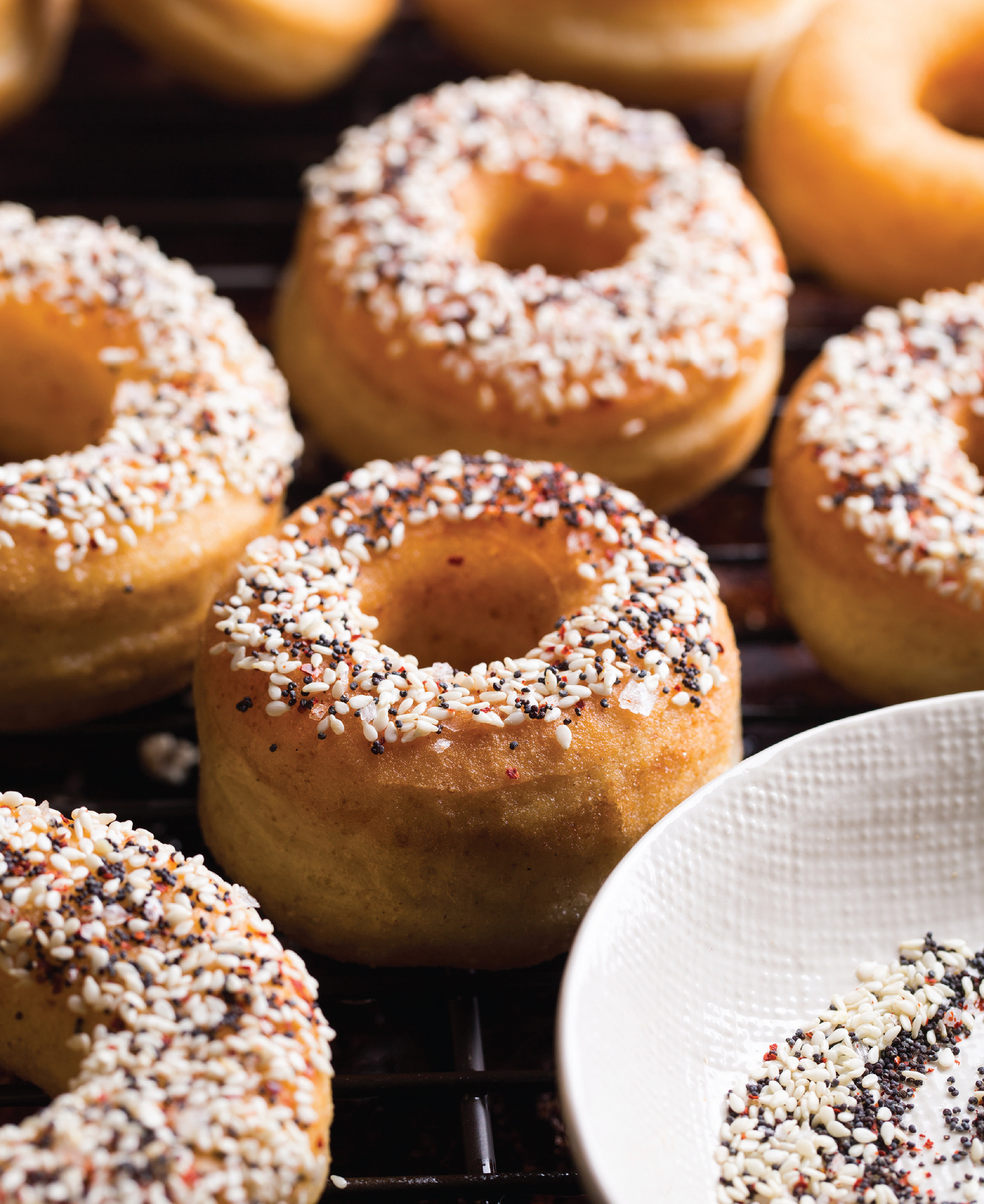
SAVORY WHOLE WHEAT RAISED
Not all doughnuts have to be sweet! This savory whole wheat version may completely change your expectations of what a doughnut should be. Make them your own with your choice of savory spices and herbs.
MAKES 8 TO 12 DOUGHNUTS | ACTIVE TIME: 25 MINUTES | READY IN: 3 HOURS
1 tablespoon plus 1 teaspoon active dry yeast, divided
1 cup whole milk, heated to 110 degrees F, divided
1½ cups (180 grams) bread flour, divided
1 cup (120 grams) rye flour
¾ cup (90 grams) whole wheat flour
3 egg yolks, at room temperature
1 teaspoon savory herbs or dried aromatics, such as caraway, rosemary, or dried onion
1 tablespoon superfine sugar
½ teaspoon kosher salt
¼ cup (½ stick) unsalted butter or vegetable shortening, at room temperature
Vegetable oil for frying
2 tablespoons unsalted butter, melted
Flaky sea salt, sesame seeds, poppy seeds, or other toppings for garnish
• In a medium bowl, dissolve 1 tablespoon of the yeast in ¾ cup of the milk. Add 1 cup of the bread flour and stir to create a smooth paste. Cover the bowl with plastic wrap and let it rest in a warm spot for 30 minutes.
• In a small bowl, mix the remaining ½ cup bread flour, the rye flour, and whole wheat flour.
• In the bowl of a stand mixer fitted with the paddle attachment, combine the remaining ¼ cup milk and 1 teaspoon yeast with a spoon. Add the rested flour mixture, egg yolks, and herbs. Mix on low speed until smooth. Turn off the mixer and add 1 cup of the combined flours, the sugar, and salt. Mix on low speed for about 30 seconds or until the dough starts to come together. Add the butter and mix on medium speed until incorporated, about 30 seconds.
• Switch to the dough hook attachment. With the mixer turned off, add more flour, about ¼ cup at a time, and knead the dough on medium speed between additions, until the dough pulls completely away from the sides of the bowl and is smooth. It will be very soft and moist, but not so sticky that you can’t roll it out. You may have flour left over. Cover the bowl with plastic wrap and let it sit in a warm spot for 30 minutes. Gently degas the dough and refrigerate for at least 1 hour (and up to 12 hours).
• Roll out and cut the doughnuts, let rise, and fry as directed for Basic Raised doughnuts.
• Brush the top of each doughnut with melted butter, and sprinkle with toppings like flaky sea salt, sesame seeds, or whatever you might like on a bagel.
NOTE: Want your savory doughnuts a bit lighter, like their sweet cousins? Switch out half of the rye flour and all of the whole wheat flour with an equal amount of bread flour.
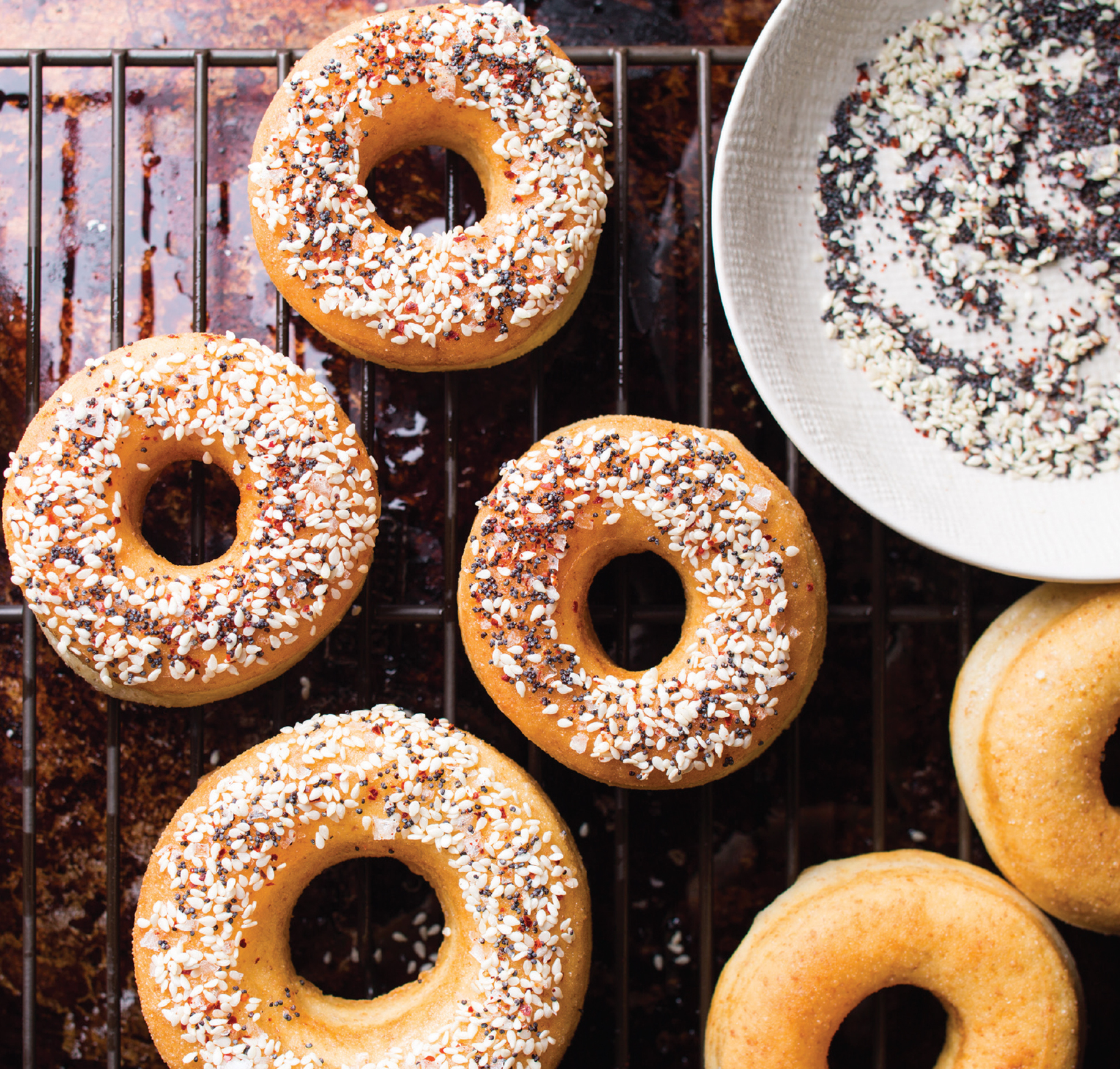
MALASADAS
Malasadas are small yeast doughnuts, usually cut square, that originated in Portugal and became very popular in Hawaii, where they are served hot and dusted with sugar or filled with custard or fruit preserves.
MAKES 12 TO 20 MALASADAS | ACTIVE TIME: 30 MINUTES | READY IN: 3 HOURS
2 tablespoons lukewarm water
1 tablespoon active dry yeast
½ cup (120 grams) superfine sugar, divided, plus more for dusting
3 eggs, at room temperature
2 tablespoons unsalted butter or vegetable shortening, melted
½ cup whole milk, at room temperature
½ cup half-and-half, at room temperature
¼ teaspoon kosher salt
3 to 4 cups (360 to 480 grams) bread flour
Vegetable oil for frying
• In a small bowl, sprinkle the water with the yeast and 1 teaspoon of the sugar. Stir and let sit until foamy, about 5 minutes.
• In the bowl of a stand mixer fitted with the paddle attachment, beat the eggs on medium speed until thick. Add the yeast mixture, the remaining sugar, the butter, milk, half-and-half, and salt. Mix on low speed until just combined.
• Switch to the dough hook attachment. With the mixer turned off, add more flour about ½ cup at a time, and knead the dough on medium speed between additions, until the dough pulls completely away from the sides of the bowl and is smooth. The dough will be moist, but not too sticky. You may have flour left over.
• Cover the dough with plastic wrap and let it rise in a warm spot until doubled in size, about 1 hour. Flip the dough over, cover, and let rise until doubled in size again, about 1 hour.
• In a heavy-bottomed pot, heat at least 2 inches of oil until a deep-fat thermometer registers 350 degrees F.
• Roll out the dough on a lightly floured surface to ½ inch thick, then with a knife cut it into 2-inch squares. For more rustic-looking malasadas, you can just pinch off small balls of the unrolled dough and press them flat between your palms.
• With a metal spatula, carefully put the doughnuts in the oil. Fry for 1 to 2 minutes on each side, or until golden. Remove with a slotted spoon and drain briefly on a paper towel. Fill a paper bag with sugar, add the doughnuts, and shake. Serve immediately.
BASIC CAKE
Making these subtly spiced cake doughnuts is so easy and quick. They are the perfect pairing with coffee, in the morning or even for dessert.
MAKES 8 TO 12 TRADITIONAL DOUGHNUTS OR 25 TO 35 DROP DOUGHNUTS ACTIVE TIME: 15 MINUTES | READY IN: 40 MINUTES
2 cups (240 grams) all-purpose flour, sifted
⅓ cup (80 grams) superfine sugar
2 teaspoons baking powder
½ teaspoon kosher salt
½ teaspoon freshly grated nutmeg or ground allspice
2 tablespoons unsalted butter or vegetable shortening, at room temperature
½ cup whole milk, scalded and cooled, divided
1 egg, at room temperature
2 tablespoons plain yogurt, at room temperature
1 teaspoon vanilla extract
Vegetable oil for greasing and frying
• In the bowl of a stand mixer fitted with the paddle attachment, combine the flour, sugar, baking powder, salt, and nutmeg. Blend on low speed. Add the butter and blend at medium-low speed until the mixture resembles coarse sand.
• In a small bowl, combine ¼ cup of the milk, the egg, yogurt, and vanilla. With the mixer on medium speed, slowly pour the wet ingredients into the flour mixture. Scrape down the sides of the bowl and mix for 20 seconds. Add the remaining ¼ cup milk, a little at a time, until the batter sticks to the sides of the bowl. The batter should be smooth, thick, and pipeable, similar to moist cookie dough. You may not need all of the milk. Cover with plastic wrap and let rest for 15 to 20 minutes.
• In a heavy-bottomed pot, heat at least 2 inches of oil until a deep-fat thermometer registers 360 degrees F.
• For traditional doughnuts, spoon the batter into a pastry bag fitted with a ⅓-inch round tip. Determine how many 3-inch doughnuts can fry in your pot at one time without crowding. Grease a 4-inch parchment square for each doughnut and pipe a 3-inch-diameter ring onto each square. Carefully put one in the oil, parchment side up. Remove the parchment with tongs and repeat with a few more rings, being careful not to overfill the pan. Fry for 1 to 2 minutes on each side, or until light golden brown.
• For drop doughnuts, drop tablespoon-size dollops directly into the oil, being careful not to overfill the pan, and fry for about 45 seconds on each side, or until light golden brown.
• Remove with a slotted spoon and drain on a paper towel. Repeat with the remaining batter. Let cool just slightly before glazing and eating.
NOTE: To scald milk, place the milk in a heavy-bottomed pot over medium heat, stirring occasionally until the milk reaches 180 degrees F. The surface of the milk will be steamy and a bit foamy. Continue to cook for about 15 seconds, and remove from heat and cool at room temperature for about 5 minutes.

BAKED CAKE
Cake doughnuts are fried, not baked, at your local doughnut shop. But this recipe bakes up just as delicious, not to mention a bit less guilt inducing, and cleanup is far easier. This batter also turns out beautifully in an electric doughnut maker.
MAKES 8 TO 12 DOUGHNUTS | ACTIVE TIME: 15 MINUTES | READY IN: 30 MINUTES
1 cup (120 grams) all-purpose flour
¼ cup (30 grams) whole wheat pastry flour
1 teaspoon baking powder
⅓ cup (80 grams) superfine sugar
½ teaspoon freshly grated nutmeg or ground allspice
½ teaspoon kosher salt
2 tablespoons unsalted butter or vegetable shortening, at room temperature
1 egg, beaten, at room temperature
¼ cup whole milk, scalded and cooled
¼ cup plain yogurt, at room temperature
1 teaspoon vanilla extract
Vegetable oil for greasing
• Preheat the oven to 350 degrees F. Lightly grease a doughnut pan.
• In a large bowl, sift the flours and baking powder. Whisk in the sugar, nutmeg, and salt. Add the butter and use your clean fingers to rub it into the dry ingredients as you would when making a pastry crust, until evenly distributed and butter chunks are smaller than pea-size. Add the egg, milk, yogurt, and vanilla, and stir until just combined. Do not overmix or your doughnuts may be rubbery.
• Use a pastry bag or a spoon to fill each doughnut cup about three-quarters full, making sure the center post is clear. Bake until the doughnuts are a light golden brown and spring back when touched, 6 to 10 minutes. Let them cool slightly before removing from the pan and glazing.
NOTE: To get the proper doughnut shape when baking cake doughnuts, you do need a doughnut pan (see here). Baking them on a flat baking sheet will result in flat-bottomed half doughnuts. If you don’t have a doughnut pan, you can bake this batter in a muffin tin for classic-doughnut-flavored muffins. The batter also works great with a mini-muffin tin for bite-size treats.
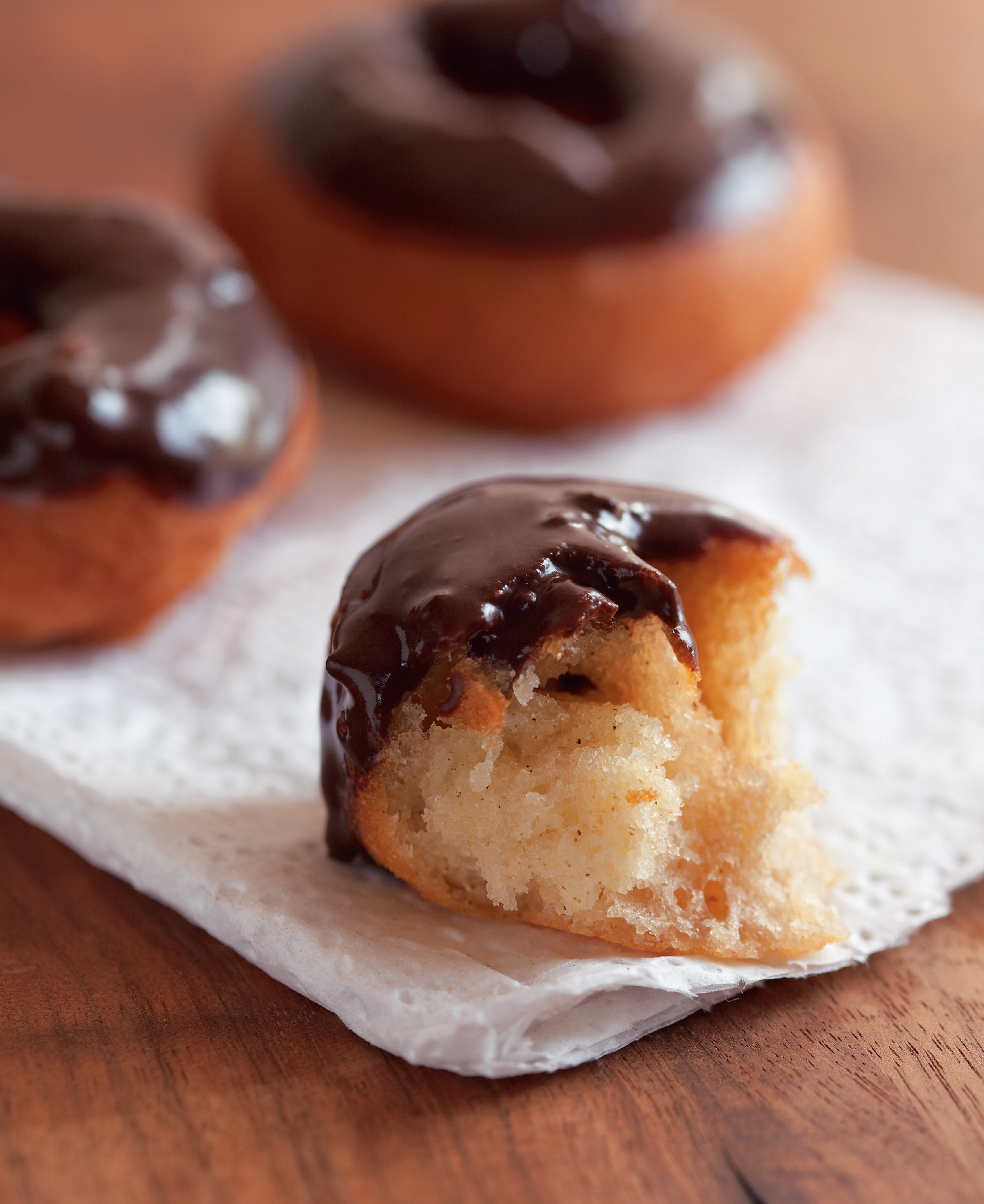
GLUTEN-FREE CAKE
These lightly spiced cake doughnuts are a real treat for those who can’t tolerate gluten in their diet.
MAKES 8 TO 12 TRADITIONAL DOUGHNUTS OR 25 TO 35 DROP DOUGHNUTS ACTIVE TIME: 15 MINUTES | READY IN: 40 MINUTES
2 cups (280 grams) Gluten-Free Baking Mix for Cake Doughnuts
⅓ cup (80 grams) superfine sugar
1 tablespoon baking powder
½ teaspoon guar gum
½ teaspoon kosher salt
½ teaspoon freshly grated nutmeg or ground allspice
¼ cup (½ stick) unsalted butter or vegetable shortening, at room temperature
2 eggs, separated, at room temperature
⅔ cup whole milk, scalded and cooled
¼ cup plain yogurt, at room temperature
2 teaspoons vanilla extract
Vegetable oil for frying
Pinch of cream of tartar
• In the bowl of a stand mixer fitted with the paddle attachment, combine the baking mix, sugar, baking powder, guar gum, salt, and nutmeg. Blend on low speed. Add the butter and blend on medium-low speed until the mixture resembles coarse sand.
• In a small bowl, combine the egg yolks, milk, yogurt, and vanilla. With the mixer on medium speed, slowly pour the wet ingredients into the baking mixture. Scrape down the sides of the bowl and mix for 30 seconds. The batter should be smooth, thick, and pipeable, similar to moist cookie dough. Cover the bowl with a towel or plastic wrap. Let rest for 15 to 20 minutes.
• In a heavy-bottomed pot, heat at least 2 inches of oil until a deep-fat thermometer registers 350 degrees F.
• Either by hand in a medium bowl or with the whisk attachment of a stand mixer, whisk the egg whites and cream of tartar until soft peaks form. Fold the egg whites into the rested batter. Pipe and fry the doughnuts as directed for Basic Cake doughnuts.
VARIATION: For a chocolate version, add ¼ cup (15 grams) unsweetened natural cocoa powder, ½ teaspoon baking soda, and an additional 2 tablespoons superfine sugar to the baking mixture.
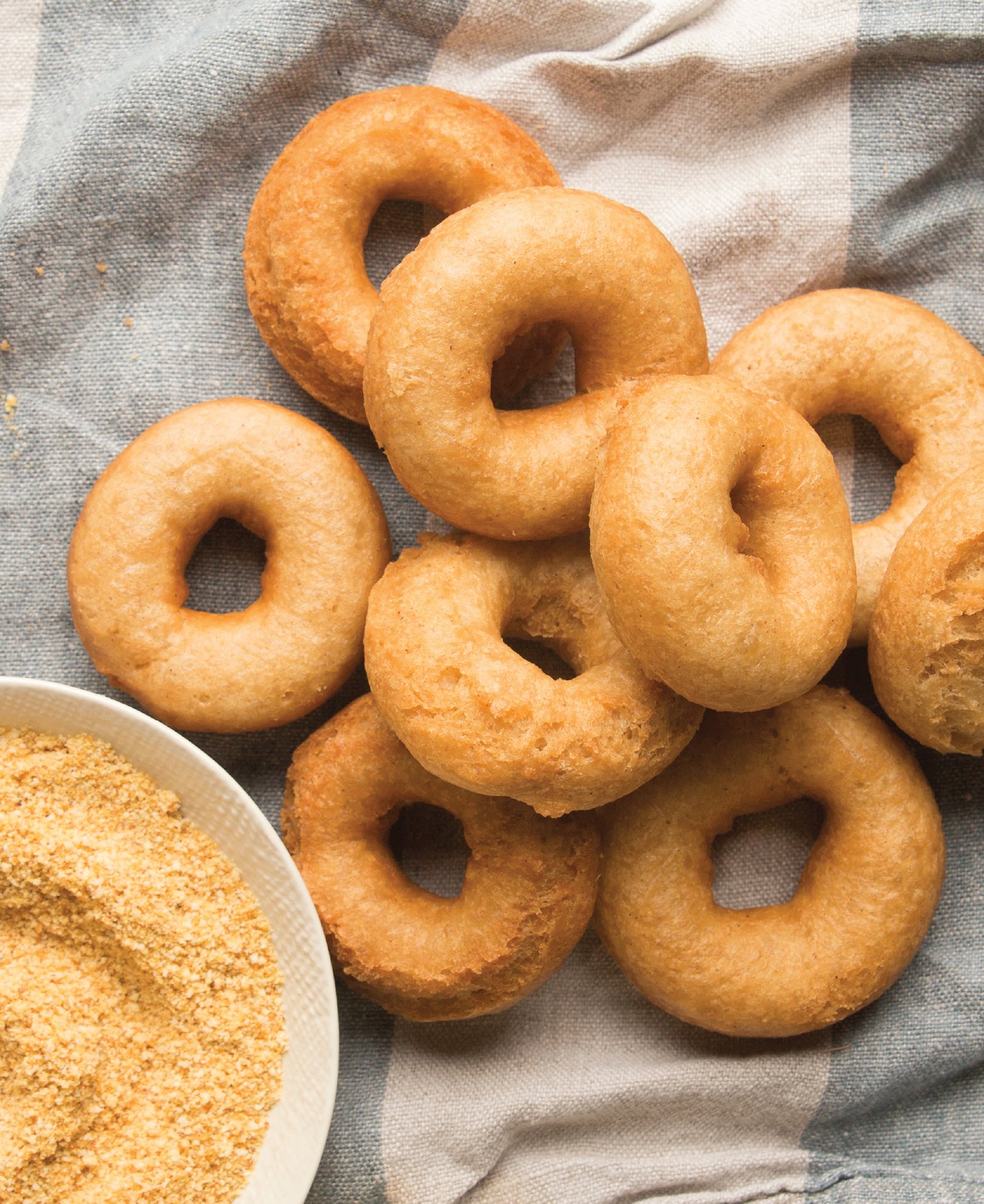
VEGAN CAKE
In the first edition of this book, this recipe included guar gum to help replace the function of eggs in the batter. It worked, and the doughnuts were good, but gums are expensive and aren’t used in the kitchen very often. Then I discovered aquafaba, that oft-discarded bean water that comes in a can of chickpeas, whips up into perfect vegan meringues.
MAKES 8 TO 12 TRADITIONAL DOUGHNUTS OR 25 TO 35 DROP DOUGHNUTS ACTIVE TIME: 15 MINUTES | READY IN: 40 MINUTES
2 cups (240 grams) all-purpose flour, sifted
⅓ cup (80 grams) superfine sugar
2 teaspoons baking powder
½ teaspoon kosher salt
½ teaspoon freshly grated nutmeg or ground allspice
2 tablespoons coconut oil or vegetable shortening, at room temperature
½ cup almond milk, scalded and cooled, divided
3 tablespoons strained aquafaba, at room temperature
2 tablespoons plain soy yogurt, at room temperature
1 teaspoon vanilla extract
Vegetable oil for greasing and frying
• In the bowl of a stand mixer fitted with the paddle attachment, combine the flour, sugar, baking powder, salt, and nutmeg, and blend on low speed. Add the coconut oil and blend on medium-low speed until the mixture resembles coarse sand.
• In a small bowl, mix ¼ cup of the milk, the aquafaba, yogurt, and vanilla. With the mixer on medium speed, slowly pour the wet ingredients into the flour mixture. Scrape down the sides of the bowl and mix for 20 seconds. Add the remaining ¼ cup milk, a little at a time, until the batter sticks to the sides of the bowl. The batter should be smooth, thick, and pipeable, similar to moist cookie dough. You may not need all of the milk. Cover the dough with plastic wrap and let rest for 15 to 20 minutes.
• Pipe and fry the doughnuts as directed for Basic Cake doughnuts
VARIATION: For a chocolate version, add ¼ cup (15 grams) unsweetened natural cocoa powder, ½ teaspoon baking soda, and an additional 2 tablespoons superfine sugar to the flour mixture.

CHOCOLATE CAKE
These rich chocolate cake doughnuts are a bit more chocolaty than the doughnuts you find in chain doughnut stores, which, let’s face it, are more brown than chocolate. If you prefer them less chocolaty, you can reduce the amount of cocoa powder to ¼ cup. If you use Dutch processed cocoa powder, use half the amount of baking soda.
MAKES 8 TO 12 DOUGHNUTS | ACTIVE TIME: 15 MINUTES | READY IN: 40 MINUTES
2 cups (240 grams) all-purpose flour, sifted
½ cup (120 grams) superfine sugar
⅓ cup (27 grams) unsweetened natural cocoa powder
½ tablespoon baking powder
½ teaspoon baking soda
½ teaspoon kosher salt
2 tablespoons unsalted butter or vegetable shortening, at room temperature
1 egg, at room temperature
½ cup whole milk, scalded and cooled
2 tablespoons plain yogurt, at room temperature
1 teaspoon vanilla extract
Vegetable oil for frying
• In the bowl of a stand mixer fitted with the paddle attachment, combine the flour, sugar, cocoa powder, baking powder, baking soda, and salt, and blend on low speed. Add the butter and blend on medium-low speed until the mixture resembles coarse sand.
• In a small bowl, combine the egg, milk, yogurt, and vanilla. With the mixer on medium speed, slowly pour the wet ingredients into the flour mixture. Scrape down the sides of the bowl and mix for 30 seconds. The batter should be smooth, thick, and not too wet, similar to sugar cookie dough. Cover the bowl with a towel or plastic wrap. Let the dough rest for 15 to 20 minutes.
• In a heavy-bottomed pot, heat at least 2 inches of oil until a deep-fat thermometer registers 360 degrees F.
• Roll out the dough on a generously floured surface to ½ inch thick. With a doughnut or cookie cutter, cut out 3-inch rounds with 1-inch holes. Brush off any excess flour.
• With a metal spatula, carefully put the doughnuts in the oil. Fry for 1 to 2 minutes on each side. Remove with a slotted spoon and drain on a paper towel. Let cool just slightly before glazing.
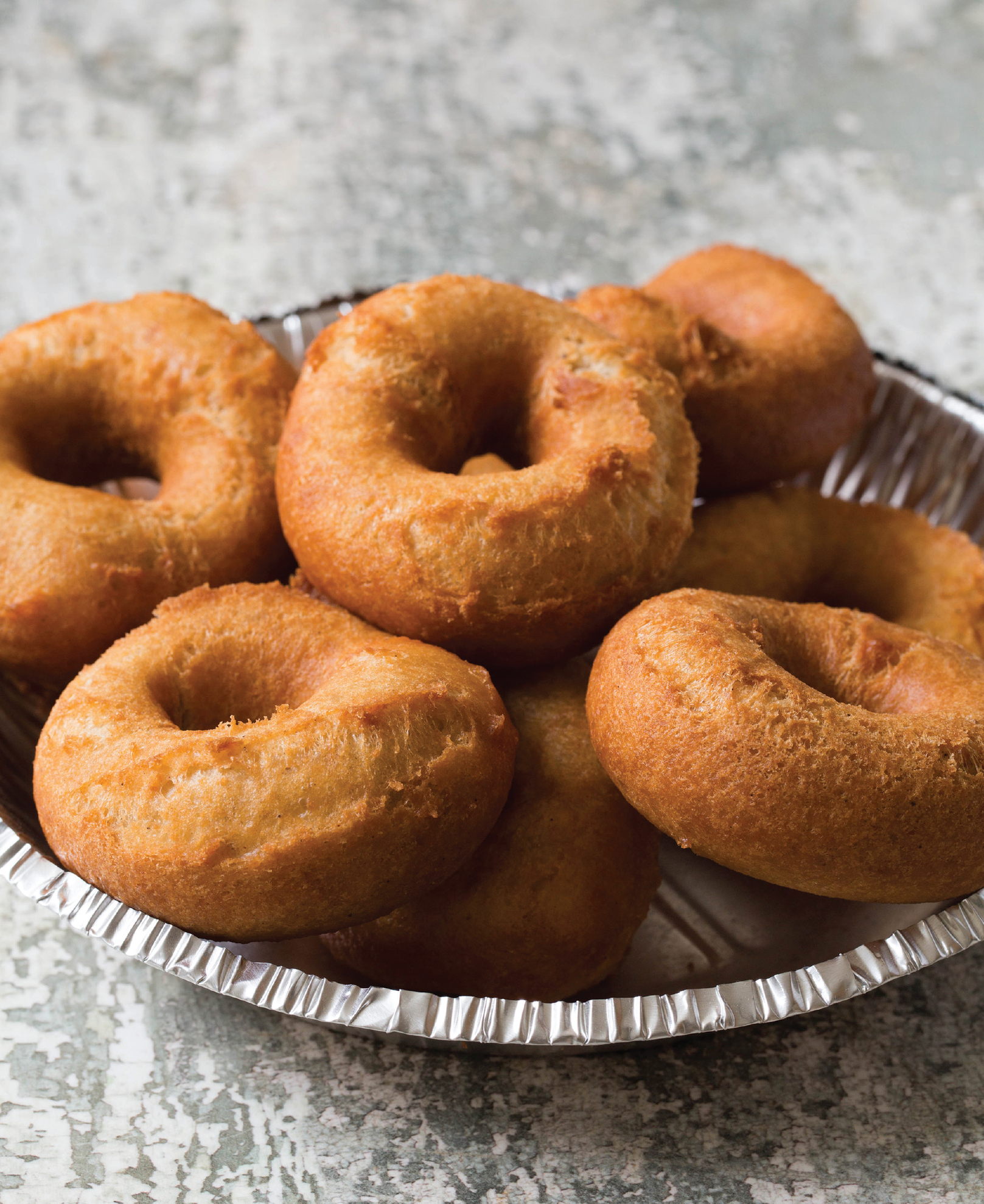
SOURDOUGH CAKE
A little sourdough starter in your cake doughnuts gives a nice tang and tenderness to these quick-to-make doughnuts.
MAKES 8 TO 12 TRADITIONAL DOUGHNUTS OR 25 TO 35 DROP DOUGHNUTS ACTIVE TIME: 15 MINUTES | READY IN: 40 MINUTES (with active sourdough starter)
2 cups (240 grams) all-purpose flour, sifted
⅓ cup (80 grams) superfine sugar
2 teaspoons baking powder
½ teaspoon kosher salt
½ teaspoon freshly grated nutmeg or allspice
¼ cup Sourdough Starter
2 tablespoons unsalted butter or vegetable shortening, at room temperature
1 egg, at room temperature
2 tablespoons whole milk, at room temperature
2 tablespoons plain yogurt, at room temperature
1 teaspoon vanilla extract
1 to 4 tablespoons water
Vegetable oil for greasing and frying
• In the bowl of a stand mixer fitted with the paddle attachment, combine the flour, sugar, baking powder, salt, and nutmeg. Blend on low speed. Add the sourdough starter and butter and blend on medium-low speed until the mixture resembles coarse sand.
• In a small bowl, combine the egg, milk, yogurt, and vanilla. With the mixer on medium speed, slowly pour the wet ingredients into the flour mixture. Scrape down the sides of the bowl and mix for 20 seconds. Add water, 1 tablespoon at a time, until the batter sticks to the sides of the bowl. The batter should be smooth, thick, and pipeable, similar to moist cookie dough. Cover with a towel or plastic wrap and let rest for 30 minutes.
• Pipe and fry the doughnuts as directed for Basic Cake doughnuts.

OLD-FASHIONED SOUR CREAM
What’s the difference between a cake doughnut and an old-fashioned? The two are sibling pastries. Cake doughnuts are the straitlaced ones; old-fashioned, contrary to the name, are a bit on the wild side. As they fry, they split and crack all over the place, making a crisp crust with all sorts of crags to catch glaze and frosting flavors.
MAKES 8 TO 12 DOUGHNUTS | ACTIVE TIME: 15 MINUTES | READY IN: 40 MINUTES
1¼ cups (150 grams) all-purpose flour
1 teaspoon baking soda
½ teaspoon ground cinnamon, nutmeg, or allspice
Pinch of kosher salt
⅓ cup (80 grams) superfine sugar
¼ cup sour cream, at room temperature
1 egg, at room temperature
1 tablespoon unsalted butter or vegetable shortening, at room temperature
Vegetable oil for frying
• In a small bowl, sift the flour, baking soda, and cinnamon. Stir in the salt.
• In a medium bowl, whisk the sugar, sour cream, egg, and butter until smooth. Add the flour mixture, a little at a time, and stir until a smooth dough forms. Cover the bowl with plastic wrap and refrigerate the dough for 15 to 20 minutes.
• Roll out the dough on a lightly floured surface to about ½ inch thick. With a doughnut or cookie cutter, cut out 2½-inch rounds with ½-inch holes. You can reroll any scrap dough.
• Fry as directed for Chocolate Cake doughnuts.

RICOTTA
This quick and easy batter yields plenty of the fluffiest fritters you’ve ever tasted.
MAKES 10 TO 14 TRADITIONAL DOUGHNUTS OR 25 TO 35 DROP DOUGHNUTS ACTIVE TIME: 20 MINUTES | READY IN: 20 MINUTES
1½ cups (180 grams) all-purpose flour
2 teaspoons baking powder
¼ cup (60 grams) superfine sugar
3 eggs, at room temperature
8 ounces ricotta cheese, at room temperature
1 tablespoon freshly grated lemon zest
1 teaspoon vanilla extract
Vegetable oil for frying
Confectioners’ sugar, or 1 batch Honey glaze for finishing
• In a medium bowl, sift the flour and baking powder. Stir in the superfine sugar, eggs, ricotta, lemon zest, and vanilla, mixing just enough to combine. Do not overmix. Use the batter immediately or refrigerate, covered with plastic wrap, for up to 1 day.
• Pipe and fry the doughnuts as directed for Basic Cake doughnuts.
• Sprinkle with confectioners’ sugar or drizzle with glaze.

APPLE CIDER
A little bit of graham flour makes these doughnuts a bit nuttier and helps them fry up with a wonderfully crisp, nubby crust. However, feel free to replace the graham flour with all-purpose for a more traditional apple cider doughnut.
MAKES 10 TO 14 DOUGHNUTS | ACTIVE TIME: 15 MINUTES | READY IN: 40 MINUTES
1¾ cups (210 grams) all-purpose flour
¼ cup (30 grams) graham flour
2 teaspoons ground cinnamon
2 teaspoons baking powder
1 teaspoon baking soda
½ teaspoon kosher salt
2 tablespoons unsalted butter or vegetable shortening, at room temperature
½ cup (120 grams) superfine sugar
2 egg yolks, at room temperature
¼ cup apple cider, at room temperature
¼ cup buttermilk, at room temperature
1 teaspoon vanilla extract
Vegetable oil for frying
• In a small bowl, whisk the flours, cinnamon, baking powder, baking soda, and salt.
• In the bowl of a stand mixer fitted with the paddle attachment, cream the butter and sugar on low speed. Add the egg yolks and beat on medium speed until the mixture is fluffy and pale yellow, about 3 minutes. Using a wooden spoon, stir in the cider, buttermilk, and vanilla. Add the dry ingredients and stir just until the mixture comes together to create a soft, slightly sticky dough. Cover with plastic wrap and refrigerate for 15 to 20 minutes.
• Roll out the dough on a lightly floured surface to about ½ inch thick. With a doughnut or cookie cutter, cut out 2½-inch rounds with ½-inch holes. You can reroll any scrap dough.
• In a heavy-bottomed pot, heat at least 2 inches of oil until a deep-fat thermometer registers 360 degrees F. With a metal spatula, carefully put the doughnuts in the oil, being careful not to overcrowd the pot. Fry until they turn a rich golden brown, about 1 minute on each side. Remove with a slotted spoon and drain on a paper towel. Repeat with the remaining dough. Let cool to the touch before glazing and eating.
NOTE: You can bake these doughnuts in a doughnut pan, in a 350-degree-F oven for 5 to 10 minutes, but you won’t achieve the same rich golden color.

ALE CAKE
Adding a bit of bubbly to your cake doughnut batter helps make the crumb both lighter and crisper, due to the carbon dioxide and alcohol.
MAKES 8 TO 12 TRADITIONAL DOUGHNUTS OR 25 TO 35 DROP DOUGHNUTS ACTIVE TIME: 15 MINUTES | READY IN: 40 MINUTES
2 cups (240 grams) all-purpose flour, sifted
⅓ cup (80 grams) superfine sugar
2 teaspoons baking powder
½ teaspoon kosher salt
½ teaspoon freshly grated nutmeg or ground allspice
2 tablespoons unsalted butter or vegetable shortening, at room temperature
1 egg, at room temperature
½ cup ale of choice or hard cider, divided
2 tablespoons plain yogurt, at room temperature
1 teaspoon vanilla extract
Vegetable oil for frying
• In the bowl of a stand mixer fitted with the paddle attachment, combine the flour, sugar, baking powder, salt, and nutmeg. Blend on low speed. Add the butter and blend on medium-low speed until the mixture resembles coarse sand.
• In a small bowl, combine the egg, ¼ cup of the ale, the yogurt, and vanilla. With the mixer on medium speed, slowly pour the wet ingredients into the flour mixture. Scrape down the sides of the bowl and mix for 20 seconds. Add the remaining ¼ cup ale, a little at a time, until the batter sticks to the sides of the bowl. The batter should be smooth, thick, and pipeable, similar to moist cookie dough. You may not need all of the ale. Cover with plastic wrap and let rest for 15 to 20 minutes.
• Pipe and fry the doughnuts as directed for Basic Cake doughnuts.
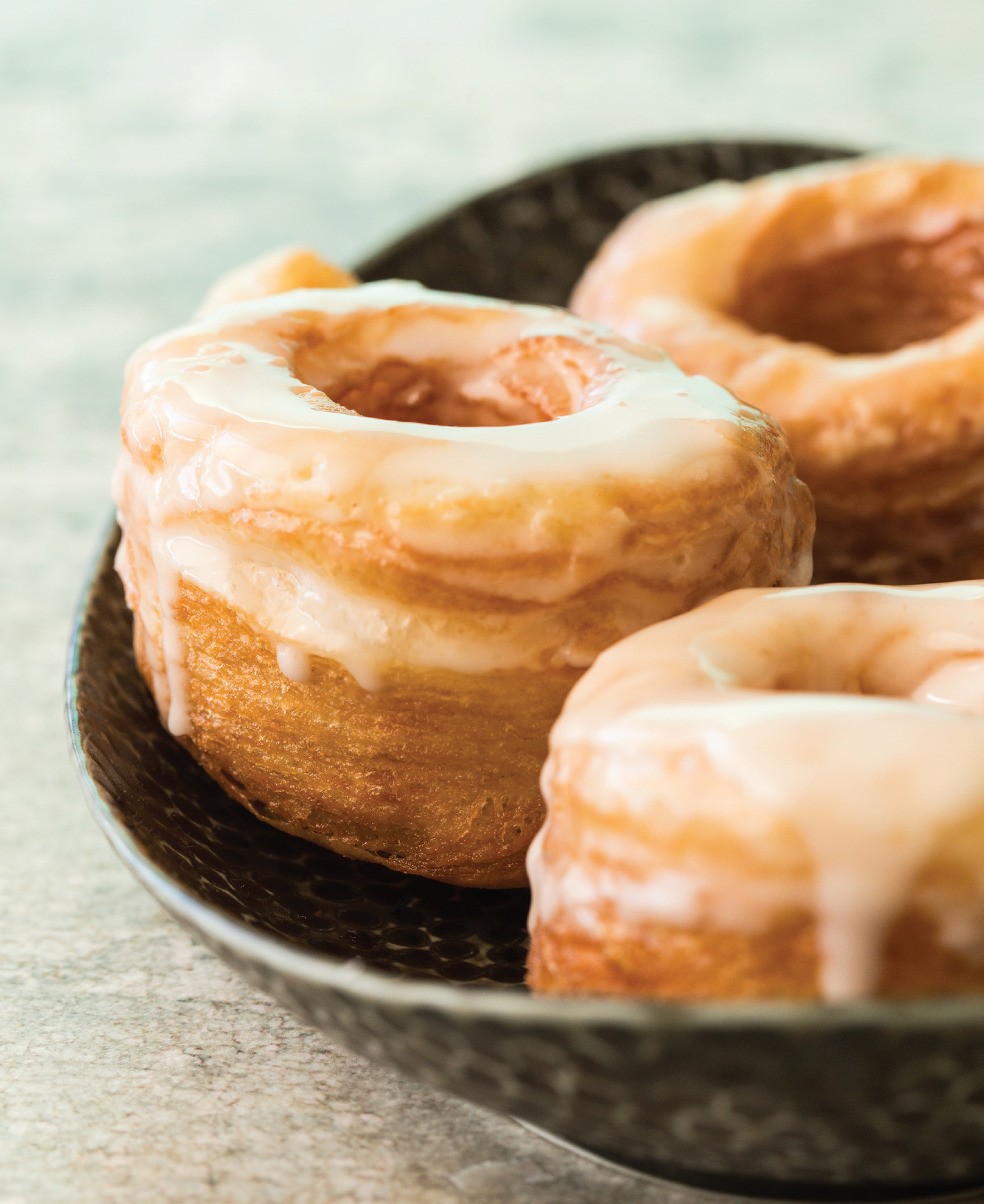
CROISSANT DOUGHNUTS
Dominique Ansel’s Cronut had hungry New York pastry lovers lining up for hours for the doughnut-croissant hybrid. For my version of the many-layered pastry, I’ve riffed on the laminated dough used in the cinnamon roll (one of my favorites) at Seattle’s Macrina Bakery. While the dough takes a couple of days to make, most of the time involves waiting in between dough rests…it’s less time consuming than waiting for hours in line!
MAKES 16 TO 20 DOUGHNUTS | ACTIVE TIME: 1 HOUR | READY IN: 2 DAYS
Day 1
1½ cups whole milk
1½ tablespoons active dry yeast
3 tablespoons superfine sugar
1 tablespoon vanilla extract
3 cups (360 grams) bread flour
½ tablespoon kosher salt
Day 2
1½ cups (3 sticks) unsalted butter, chilled
3 tablespoons bread flour, plus more for dusting
Vegetable oil for frying
1 batch glaze of choice
1 batch filling of choice, if using
• On day 1, in a small saucepan over medium heat, heat the milk until it is warm to the touch. Don’t overheat! Transfer to a large bowl and add the yeast, sugar, and vanilla and gently stir. Let it sit for about 5 minutes until bubbly.
• In a small bowl, combine the flour and salt, mixing with a wooden spoon. Slowly add the flour mixture to the milk mixture and stir until just combined. The dough will be sticky. Cover the dough with plastic wrap and refrigerate for 8 to 12 hours.
• On day 2, remove the dough from the refrigerator and punch it down.
• Cut the butter into 12 equal pieces. In the bowl of a stand mixer fitted with the paddle attachment, mix the butter and 3 tablespoons flour on low speed until the butter is completely smooth. Scoop the butter mixture onto a well-floured surface and shape into a 6-inch square about 1 inch or so thick. This is called a butter block. Lightly flour the square and wrap it in plastic wrap. Refrigerate both the dough and the butter block for about 30 minutes. You want them to be about the same temperature before proceeding.
• Line a baking sheet with parchment paper and set aside.
• Now it’s time to work the butter into the dough. On a well-floured surface, gently pat the dough into a square about 1 inch thick, then stretch the corners out about 4 inches to make a sort of X shape. Place the butter block in the center and fold the stretched corners over the butter. Pinch the edges of the dough together to completely seal the butter inside. Sprinkle the dough with a bit of flour and gently roll it out into a 12-by-20-inch rectangle. If the butter starts to poke through, pinch the dough to reseal it.
• Next, position the rectangle so that a long side is closest to you. Take the left side and fold it to the center. Fold the right side over to meet it, then fold the new left edge over the new right edge as if you are closing a book. Carefully lift the dough onto the prepared baking sheet. Cover with plastic wrap and refrigerate for 30 minutes.
• Remove the dough from the refrigerator and let sit at room temperature for 15 minutes. Repeat the rolling, folding, and chilling process two more times, for a total of three book folds and three chills. The last chill can be 30 minutes to 12 hours.
• Remove the dough from the refrigerator and cut it in half. Place one half on a lightly floured surface and return the other half, covered with plastic wrap, to the refrigerator.
• Line a baking sheet with a lightly floured non–terry cloth dish towel. Roll out the dough half to ½ inch thick. With a doughnut or cookie cutter, cut out 2½-inch rounds with 1-inch holes, and place them at least 1½ inches apart on the prepared baking sheet. Cover them with plastic wrap and repeat with the other half of the dough.
• To use dough scraps, form them into a rectangle and perform a book fold, then refrigerate for 15 minutes before rolling and cutting them. Or, even better, create cinnamon roll doughnuts (see Note).
• Let the doughnuts sit in a warm spot (70 to 80 degrees F) for 1 hour, or until doubled in size.
• While the doughnuts are proofing, in a heavy-bottomed pot, heat at least 2 inches of oil until a deep-fat thermometer registers 360 degrees F. With a metal spatula, carefully put the doughnuts in the oil. Fry for about 1 minute on each side, or until light golden brown. Remove with a slotted spoon, and drain on a wire rack set over a paper towel and cool to the touch before filling or glazing.
• To fill the doughnuts, spoon the filling into a pastry bag with a Bismarck (#230) tip. Insert the tip into the bottom of a doughnut in four equally spaced spots. Gently squeeze the pastry bag to add about 1 tablespoon filling, withdrawing the tip slowly as you squeeze. Repeat with the remaining doughnuts.
• Glaze as desired.
NOTE: To make cinnamon roll doughnuts from dough scraps, roll the chilled dough into a rectangle and sprinkle with a bit of granulated sugar and ground cinnamon. Roll the dough into a tube and cut the tube into ½-inch slices. Line a baking sheet with a lightly floured non–terry cloth dish towel, and set the slices on the towel. Cover with plastic wrap and let rise for 1 hour. Fry the doughnuts in 350-degree-F oil until they are a deep golden brown, 1 to 2 minutes on each side. You may need to fry them longer than you would normal doughnuts so that they cook all the way through. Test the first one to make sure it doesn’t have a raw center.
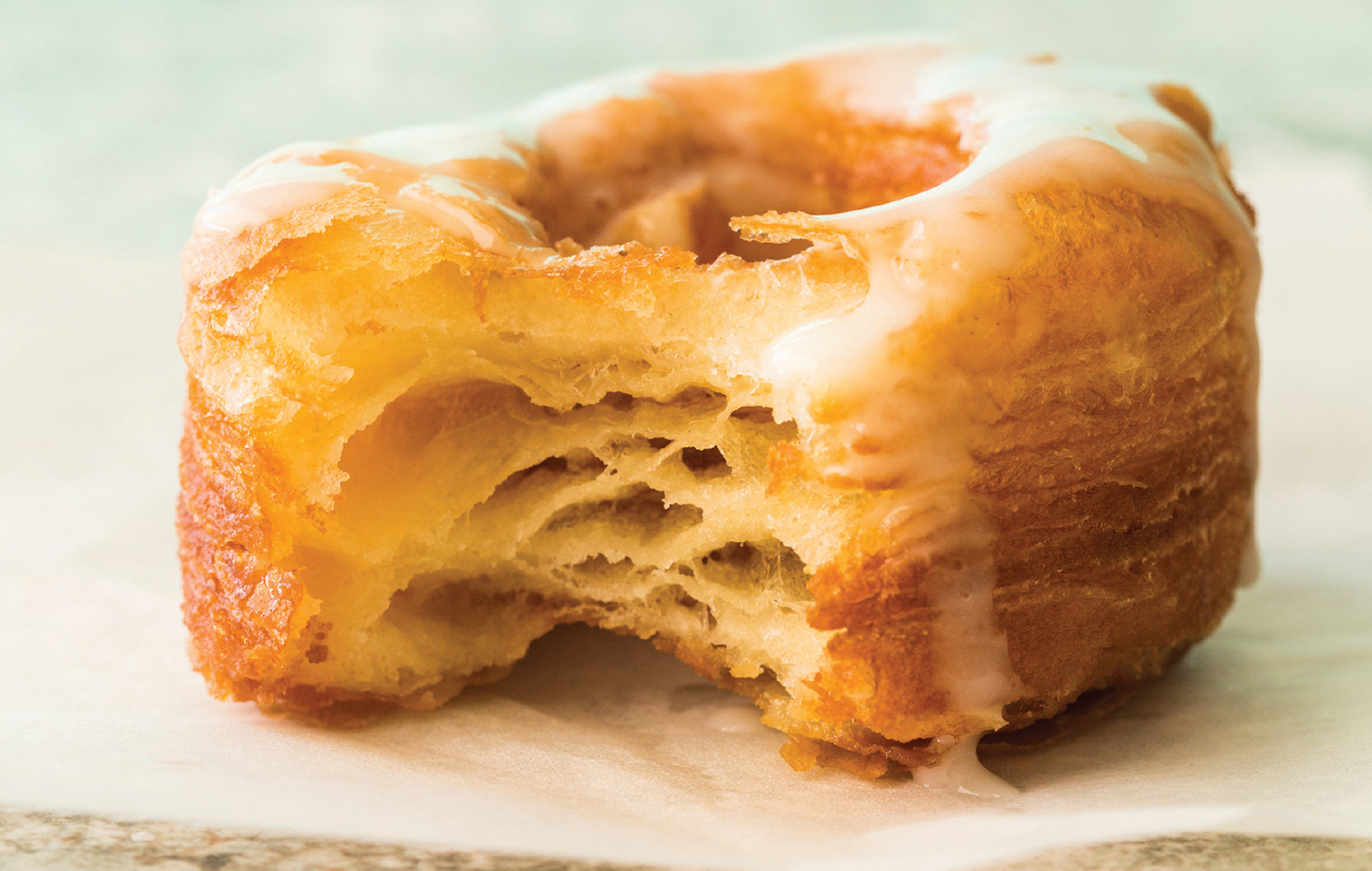
FRENCH CRULLERS
There are two kinds of crullers: hand-twisted cake doughnuts, which are more akin to maple bars, and French crullers made with pâte à choux, which are lighter than air, with all sorts of nooks and crannies to hold onto their light honey glaze. These crullers, one of my family’s favorites, are the latter.
MAKES 10 TO 14 CRULLERS | ACTIVE TIME: 30 MINUTES | READY IN: 30 MINUTES
1 cup water
6 tablespoons unsalted butter
2 teaspoons superfine sugar
¼ teaspoon kosher salt
1 cup (120 grams) all-purpose flour, sifted
3 eggs, at room temperature
2 egg whites, slightly beaten, at room temperature
Vegetable oil for greasing and frying
1 batch Honey glaze or glaze of choice
• In a heavy-bottomed pot over medium-high heat, combine the water, butter, sugar, and salt and bring to a brisk boil. Add the flour and stir with a wooden spoon until completely incorporated. Cook, stirring, for 3 to 4 minutes to steam away as much water as possible. The more moisture you can remove, the more eggs you can add later and the lighter your pastry will be. The mixture is ready when a thin film coats the bottom of the pan.
• Transfer the mixture to the bowl of a stand mixer fitted with the paddle attachment. (Although you can mix the pâte à choux by hand, this can be rather arduous, so use a mixer if you have one.) Stir the mixture on low speed for about 1 minute to allow it to cool. Increase the speed to medium and add 1 egg. Mix until it is completely incorporated, then scrape down the sides of the bowl. Add the remaining eggs, one at a time, mixing in each completely before adding the next. Add the egg whites, a little at a time, and mix until the paste becomes smooth and glossy and holds a slight peak when pinched with your fingers. Be careful not to add too much egg white or your crullers will become heavy; you may have some left over. Spoon the batter into a pastry bag fitted with a ½-inch star tip.
• In a heavy-bottomed pot, heat at least 2 inches of oil until a deep-fat thermometer registers 370 degrees F. Cut out 12 (3-inch) squares of parchment paper and lightly grease them. Pipe a ring onto each square. When the oil is hot, place one cruller at a time in the oil, parchment side up. Remove the parchment with tongs. Fry them 1 to 2 minutes on each side, or until golden brown. Remove with a slotted spoon and drain on a paper towel for at least 1 minute. Once cool to the touch, the crullers can be glazed.
NOTE: Undercooked crullers will collapse while cooling, so observe the first one and if this happens, increase the frying time (and check the oil temperature) for the rest.
NOTE: Beignets, the classic New Orleans fried dough treats, use this same batter and are even easier to prepare. Simply drop rounded teaspoonfuls of the batter into the oil. As the dough puffs, the beignets will turn themselves over—but keep an eye on them and flip any that need a little help. Once cooled, sprinkle with a little confectioners’ sugar, toss in a bag of superfine granulated sugar, or drizzle with a chocolate glaze.
VARIATION: Crullers also bake very well, although they will have slightly firmer crusts than the fried versions. Preheat the oven to 450 degrees F. Line a baking sheet with parchment paper and pipe the crullers onto it, at least 2 inches apart. Bake for 5 minutes, then reduce the heat to 350 degrees F and bake for another 15 minutes. Turn off the heat, open the oven door slightly, and let the crullers sit in the cooling oven for 10 minutes. Remove from the oven, dip in the glaze, and cool on a wire rack until the glaze has set.
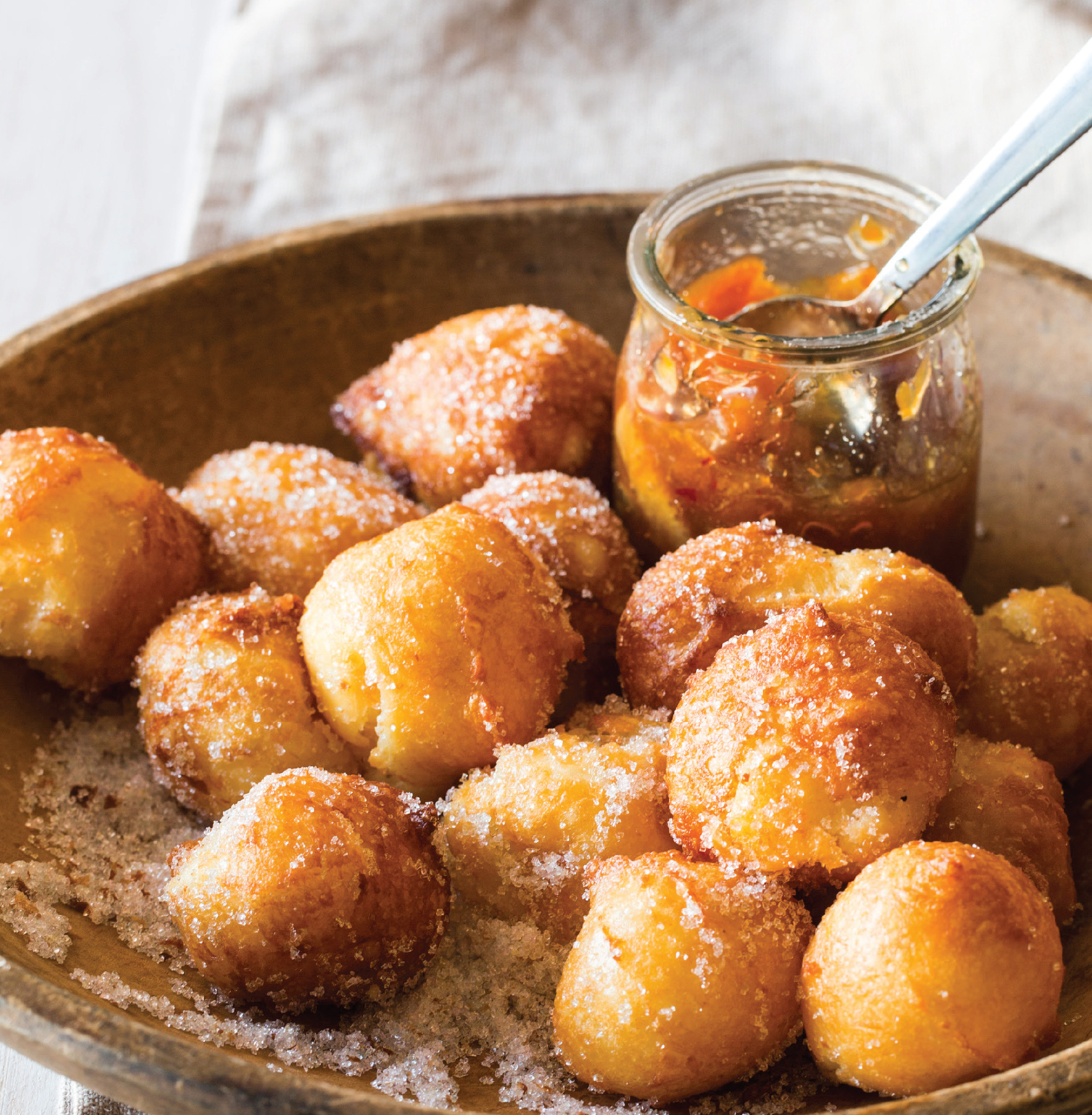
GHANAIAN DOUGHNUTS
While there are many different versions of Ghanaian doughnuts, this is the version I fell in love with. These little dough balls puff by the same magic as cream puffs, but when fried, they are the best combination of crispy crust and custardy inside. The coarser sanding sugar covering these doughnuts is reminiscent of the beaches on which these doughnuts are commonly found, but you can use any sugar you like or serve with a tropical fruit jam.
MAKES 20 TO 25 DROP DOUGHNUTS | ACTIVE TIME: 30 MINUTES READY IN: 30 MINUTES
½ cup plus 2 tablespoons water
½ cup whole milk
½ cup (1 stick) unsalted butter, cut into pieces
2 tablespoons sweetened condensed milk
½ teaspoon kosher salt
1 cup (120 grams) all-purpose flour
3 eggs, at room temperature
1 egg white, at room temperature
¼ cup sanding sugar
• In a heavy-bottomed pot over medium-high heat, combine the water, whole milk, butter, sweetened condensed milk, and salt and bring to a brisk boil. Add the flour and stir with a wooden spoon until completely incorporated. Cook, stirring, for 3 to 4 minutes to steam away as much water as possible. The more moisture you can remove, the more eggs you can add later and the lighter your pastry will be. The mixture is ready when a thin film coats the bottom of the pan.
• Transfer the mixture to the bowl of a stand mixer fitted with the paddle attachment. (Although you can mix the dough by hand, this can be rather arduous, so use a mixer if you have one.) Stir the mixture on low speed for about 1 minute to allow it to cool. Increase the speed to medium and add 1 egg. Mix until it is completely incorporated, then scrape down the sides of the bowl. Add the remaining eggs, one at a time, mixing in each completely before adding the next. Add the egg white, a little at a time, until the paste becomes smooth and glossy and holds a slight peak when pinched with your fingers. Be careful not to add too much egg white or your doughnuts may become heavy. You may not use it all.
• Place the sanding sugar in a shallow bowl or a paper bag, and set aside.
• In a heavy-bottomed pot, heat at least 2 inches of oil until a deep-fat thermometer registers 355 degrees F. When the oil is hot, drop heaping teaspoonfuls of the batter into the oil. Be careful not to overfill the pot. Fry for 1 to 2 minutes on each side, or until light golden brown. Remove with a slotted spoon and drain on a wire rack set over a paper towel for at least 1 minute, and then roll in or shake with the sanding sugar. They are lovely served warm.
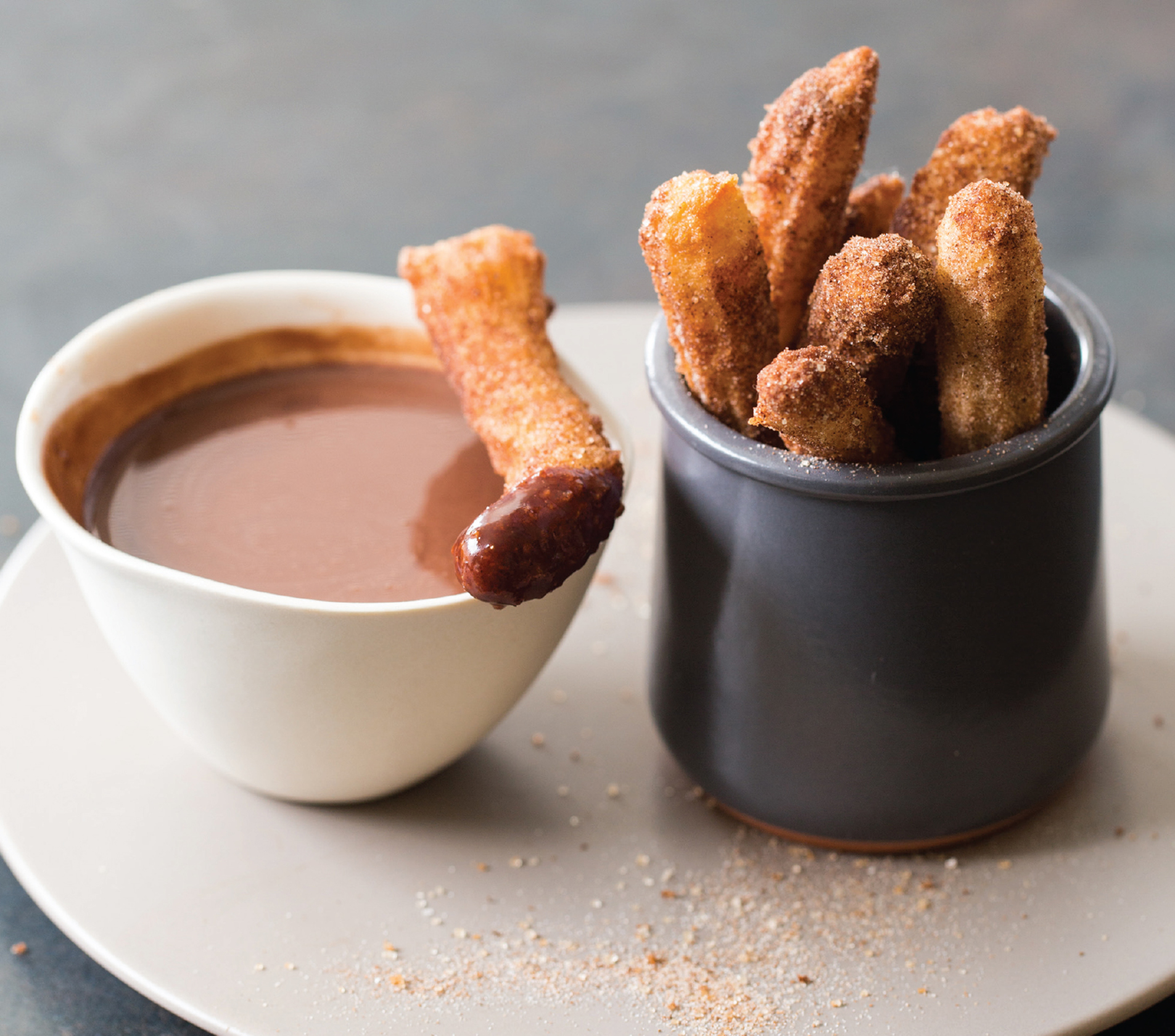
SPANISH CHURROS
These churros are based on the traditional Spanish style, which are made without eggs (versus Mexican-style churros, which are made with a dough similar to the one used for French Crullers) and have a crunchy crust with a creamy center. It’s best to make them on the small side, using a smaller piping tip, to ensure the center cooks through.
MAKES 12 TO 15 CHURROS | ACTIVE TIME: 15 MINUTES | READY IN: 30 MINUTES
1 cup (120 grams) all-purpose flour, sifted
1 teaspoon kosher salt
1 tablespoon olive oil
1½ cups boiling water, divided
Vegetable oil for greasing and frying
2 tablespoons superfine sugar
1 tablespoon ground cinnamon
Chocolate Sauce (recipe follows) or Homemade Dulce de Leche
• In a large bowl, combine the flour and salt. Pour the olive oil and 1 cup of the boiling water on top. Stir the dough with a wooden spoon until the mixture is well combined and resembles mashed potatoes, 1 to 2 minutes. If the dough seems too stiff to pipe, add a bit more water. Cover the bowl with a towel and let rest for 10 minutes.
• In a small bowl, mix the sugar and cinnamon.
• Spoon the dough into a pastry bag fitted with a ¼-inch star tip. Squeeze the dough down to remove any pockets.
• Heat at least 2 inches of vegetable oil in a heavy-bottomed pot until a deep-fat thermometer registers 360 degrees F. Cut out 3 (8-by-3-inch) pieces of parchment paper and lightly grease them. Pipe a 4-inch strip of dough onto each parchment piece. When the oil is hot, put the strips in the oil one at a time, parchment side up. Remove the parchment with tongs. Fry on each side until the oil starts to bubble frantically and the churros are golden brown, 2 to 3 minutes total, flipping each one once or twice. Remove with tongs and drain on a wire rack set over a paper towel for about 30 seconds. Sprinkle with the cinnamon-sugar mixture. Repeat with the remaining dough (you can reuse the parchment strips).
• Serve the churros warm with the chocolate sauce or warmed dulce de leche.
Chocolate Sauce
MAKES ABOUT 1 CUP
⅔ cup heavy cream
2½ ounces bittersweet or semisweet chocolate, coarsely chopped
1 teaspoon cornstarch
Pinch of kosher salt
• In a small pot over low heat, heat the cream until steaming. Remove from the heat and stir in the chocolate, cornstarch, and salt. Whisk until the chocolate has completely melted and the mixture is smooth.

SOPAPILLAS
Unlike the crisp, cinnamon-sugar-and-whipped-cream-covered triangles you find in many Tex-Mex restaurants, these New Mexico–style sopapillas are like little pillows of dough and air. Serve a basket of them in place of tortillas alongside a big bowl of chile verde; offer them again for dessert with a drizzle of honey.
MAKES 6 TO 12 SOPAPILLAS | ACTIVE TIME: 20 MINUTES | READY IN: 40 MINUTES
2½ cups (300 grams) all-purpose flour, plus more for dusting
1 teaspoon baking powder
1 teaspoon kosher salt
2 tablespoons vegetable shortening or lard
⅔ cup warm water
Vegetable oil for frying
• In a medium bowl, sift the flour, baking powder, and salt. Add the shortening and gently work it in with your clean fingertips until the mixture resembles coarse crumbs. Add the water, a little at a time, and mix with a fork until the dough forms a ball. Turn it out onto a lightly floured surface and knead for about 30 seconds. Cover with plastic wrap and let rest for 30 minutes.
• In a heavy-bottomed pot, heat at least 2 inches of oil until a deep-fat thermometer registers 370 degrees F.
• On a lightly floured surface, roll out the dough very thin, ⅛ to ¼ inch thick. Cut into 3-inch squares or triangles.
• With a metal spatula, carefully put them in the oil and fry until golden and puffed, 1 to 2 minutes on each side. Only fry a couple at a time to avoid overfilling the pot. Remove with a slotted spoon and drain on a paper towel, allowing to cool just slightly.
NOTE: Sopapillas are best eaten immediately but can be kept warm in a 200-degree-F oven for up to 1 hour.
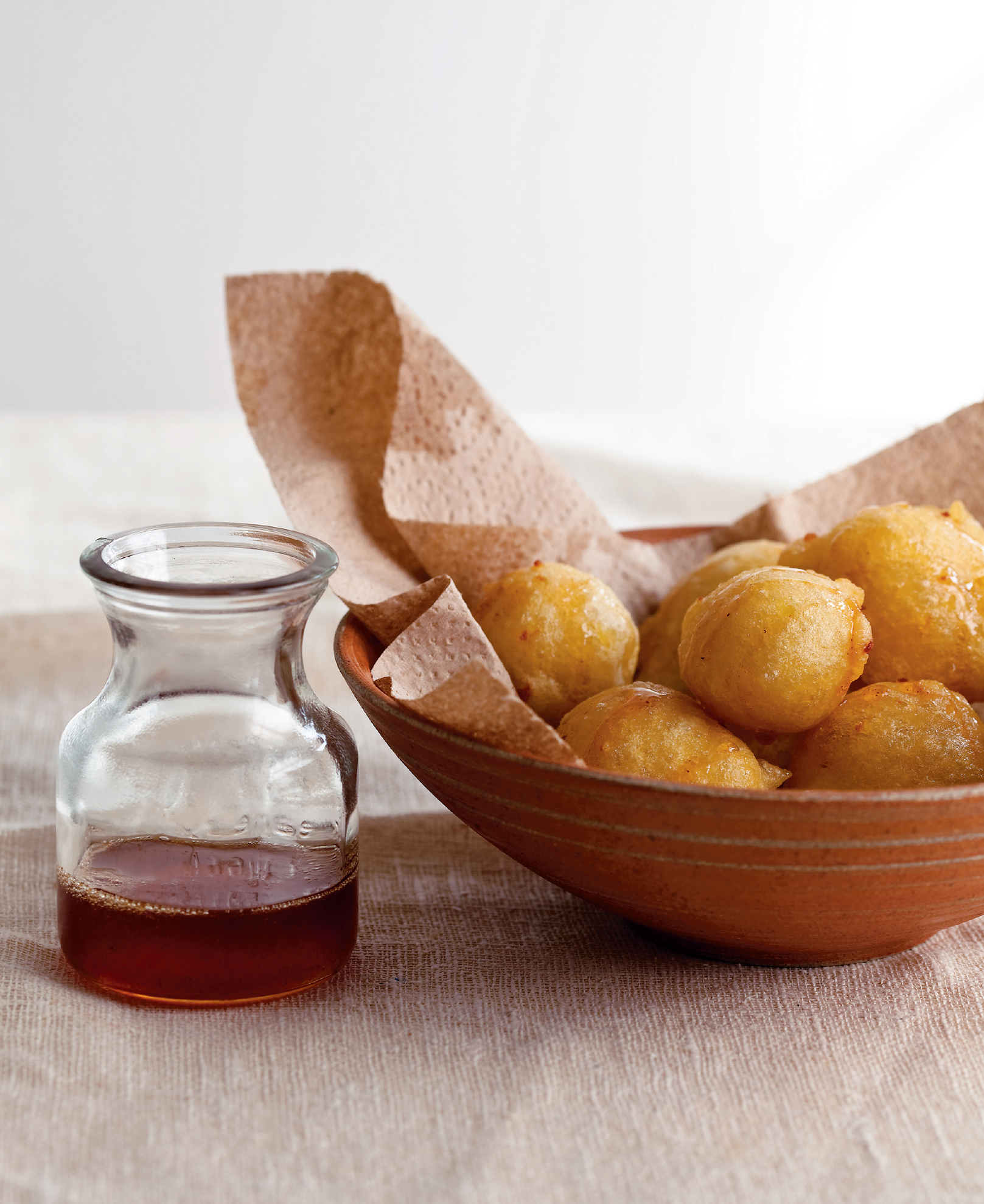
LOUKOUMADES
I first learned of these puffy little fritters, a traditional treat on the island of Cyprus, in Tessa Kiros’s beautiful cookbook Falling Cloudberries. The honey syrup is amazing too.
MAKES 20 TO 30 LOUKOUMADES | ACTIVE TIME: 30 MINUTES | READY IN: 3 HOURS
½ tablespoon active dry yeast
¾ cup lukewarm water
¾ cup (90 grams) all-purpose flour, divided
Pinch of superfine sugar
Pinch of kosher salt
1 large baking potato (about 8 ounces), peeled and halved
¼ cup honey
2 tablespoons freshly squeezed lemon juice
¼ teaspoon ground cinnamon
Splash of water
Vegetable oil for frying
• In the bowl of a stand mixer fitted with the paddle or dough attachment, combine the yeast and water. Stir to distribute the yeast. Add ¼ cup of the flour, the sugar, and salt. Stir again, cover the bowl with plastic wrap, and let sit for 20 minutes in a warm spot.
• Boil the potato until easily pierced with a fork, 10 to 15 minutes. Drain, let cool, and mash well.
• Add the potato and the remaining ½ cup flour to the yeast mixture. Beat on high speed to form a smooth, wet dough. Cover the bowl with plastic wrap and let sit in a warm spot until the batter has thickened, about 2 hours.
• Meanwhile, make the syrup. In a medium heavy-bottomed pot over medium-low heat, stir the honey, lemon juice, cinnamon, and water. Boil until the mixture thickens, about 10 minutes. Set aside.
• In a heavy-bottomed pot, heat at least 2 inches of oil until a deep-fat thermometer registers 360 degrees F. Drop in heaping teaspoonfuls of batter and fry, turning occasionally, until golden and puffed, about 1 minute. Remove with a slotted spoon. Drain on a paper towel and let cool slightly.
• To serve, place the loukoumades in a bowl and drizzle with the syrup.
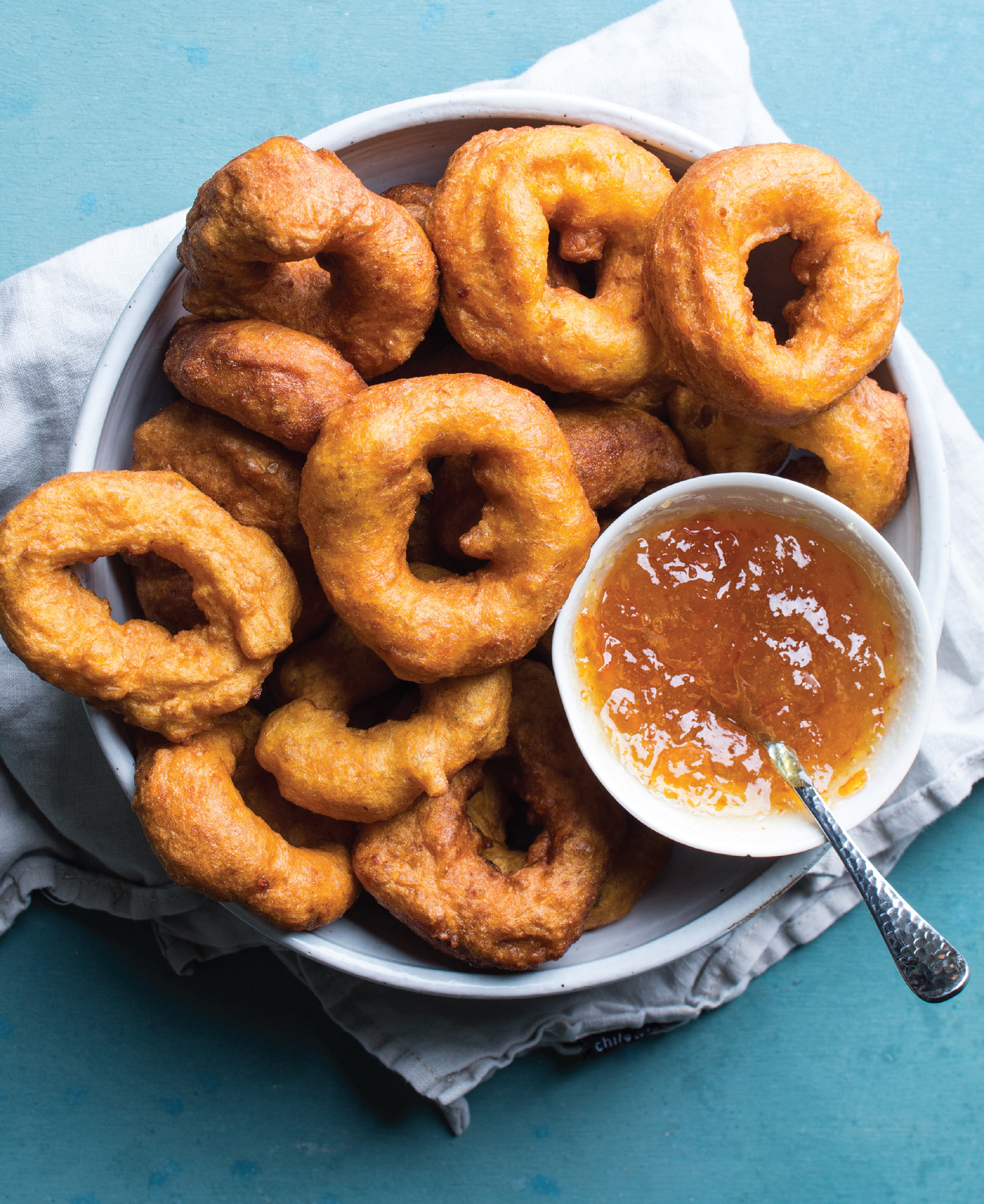
PICARONES
Picarones are sweet, ring-shaped winter squash fritters enjoyed in Peru. Traditionally they are sweetened with miel de chancaca, a sweet sauce made of raw cane sugar and honey and flavored with orange. A good sour and sweet marmalade is a simpler and equally delicious substitute.
MAKES 6 TO 12 PICARONES | ACTIVE TIME: 30 MINUTES | READY IN: 2 HOURS
½ stick cinnamon
4 whole cloves
2 tablespoons whole aniseed
1 medium yam (3 ounces), peeled and halved
4 ounces pumpkin or winter squash, peeled and cut into 3-inch chunks
2 teaspoons active dry yeast
1 teaspoon superfine sugar
Pinch of kosher salt
1½ to 2 cups (200 to 240 grams) all-purpose flour
Vegetable oil for frying
Miel de chancaca or marmalade for serving
• Bring a large pot of water to a boil. Add the cinnamon, cloves, and aniseed and simmer for 10 minutes. Strain out the spices and discard them, keeping the spiced water. Add the yam and pumpkin to the water and simmer until soft, about 10 minutes.
• Reserve 2 tablespoons of the cooking water in a small bowl, discarding the rest, and let it cool to about 110 degrees F. Add the yeast and sugar and let sit for 5 minutes.
• In the bowl of a stand mixer fitted with the paddle attachment, put the yam and pumpkin and beat on medium speed to a smooth puree. Stir in the salt and the yeast mixture. Beat on high speed until smooth. Reduce the speed to low, and add the flour, a little at a time, until a soft, elastic dough forms. If the dough is still sticky, add a bit more flour.
• Cover the dough with plastic wrap and proof in a warm spot until doubled in size, about 1 hour.
• In a heavy-bottomed pot, heat at least 2 inches of oil until a deep-fat thermometer registers 360 degrees F. Pinch off golf ball–size pieces of dough and shape them into rings with your fingers. With a metal spatula, carefully put the rings in the oil and fry 1 to 2 minutes on each side, or until golden. Remove with a slotted spoon, drain on a paper towel, and let cool slightly before serving with the miel de chancaca or marmalade on the side.
